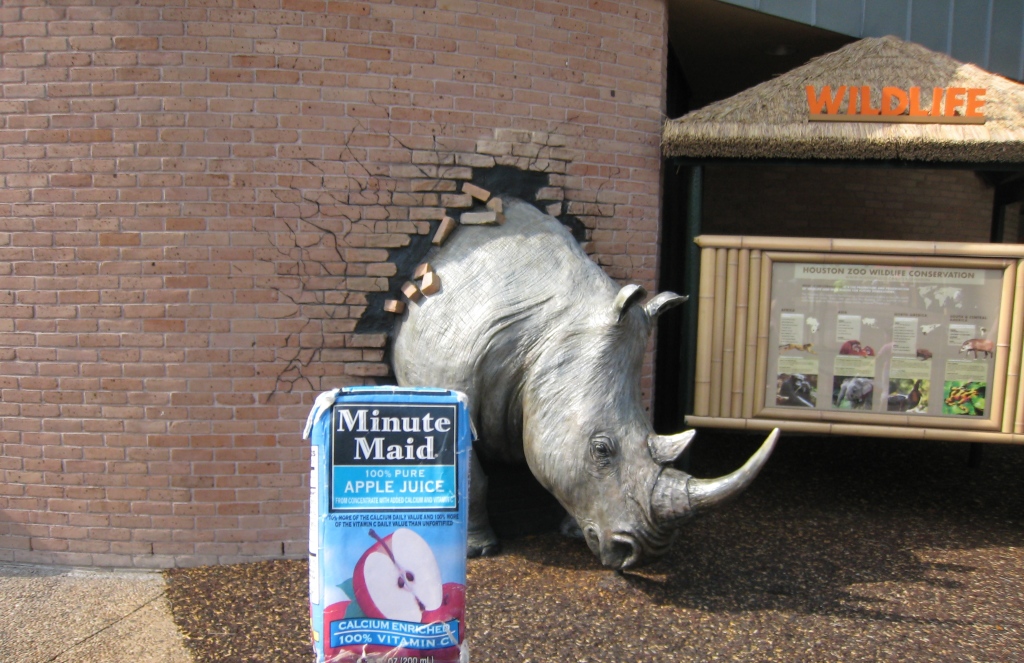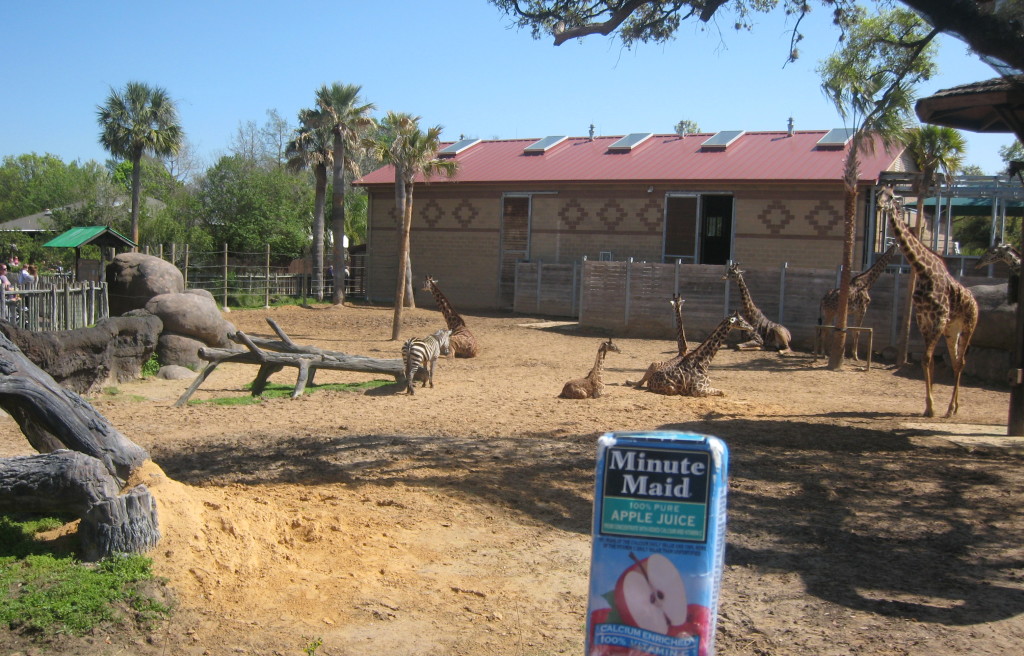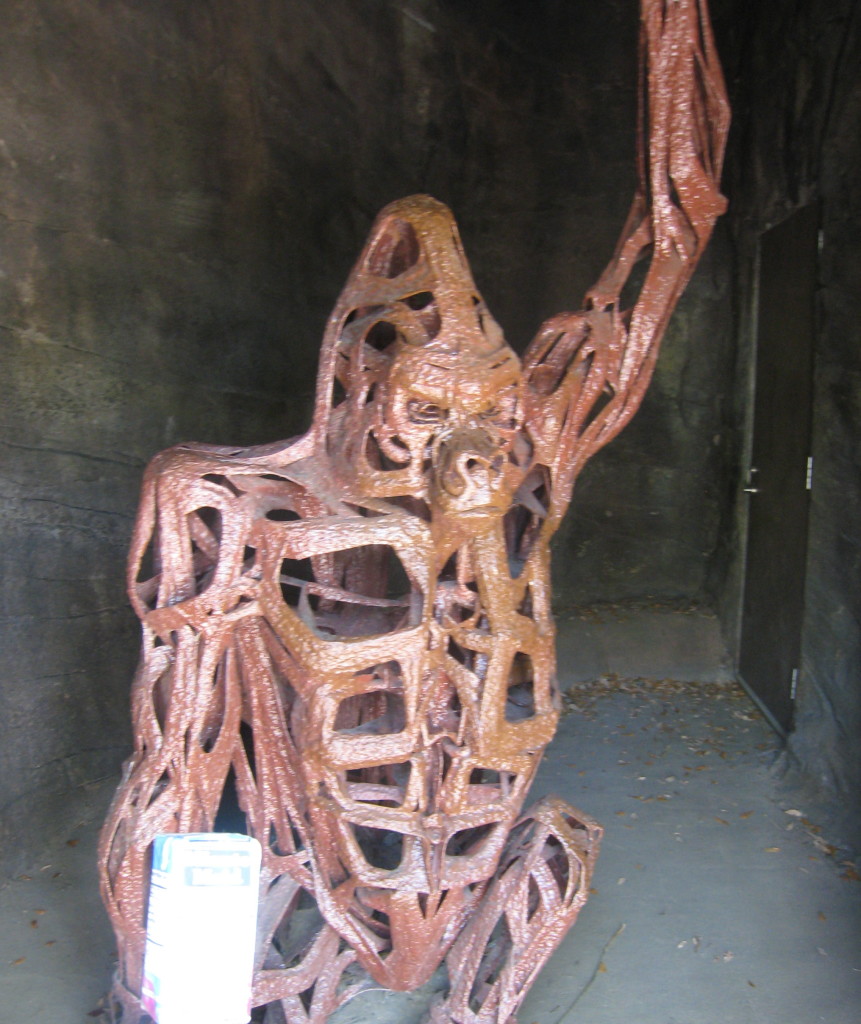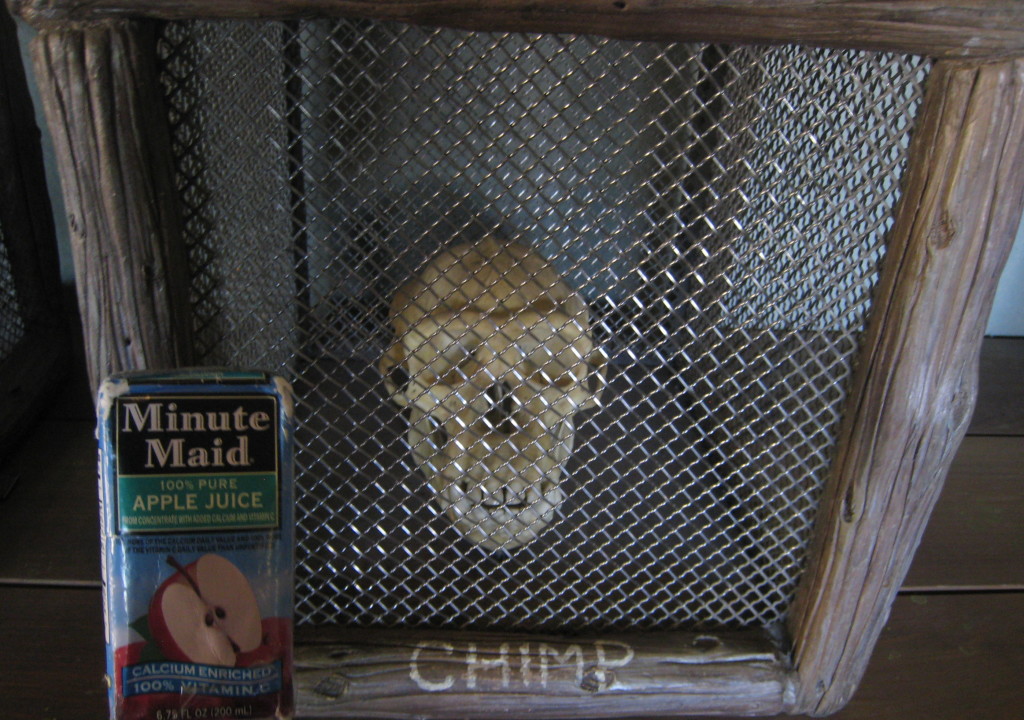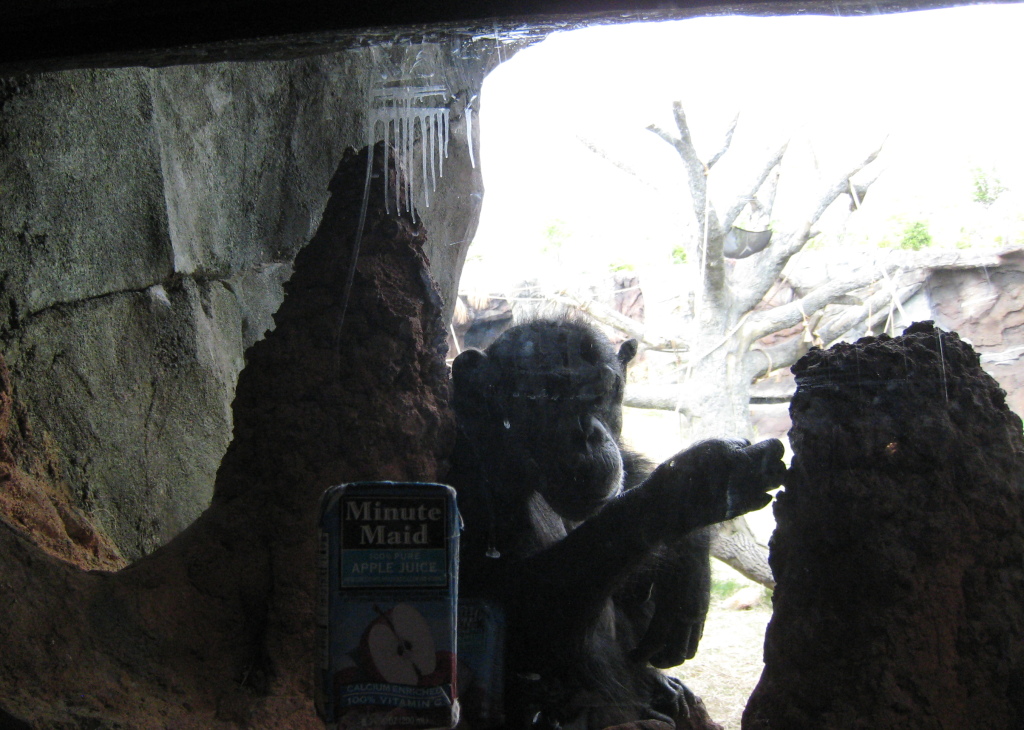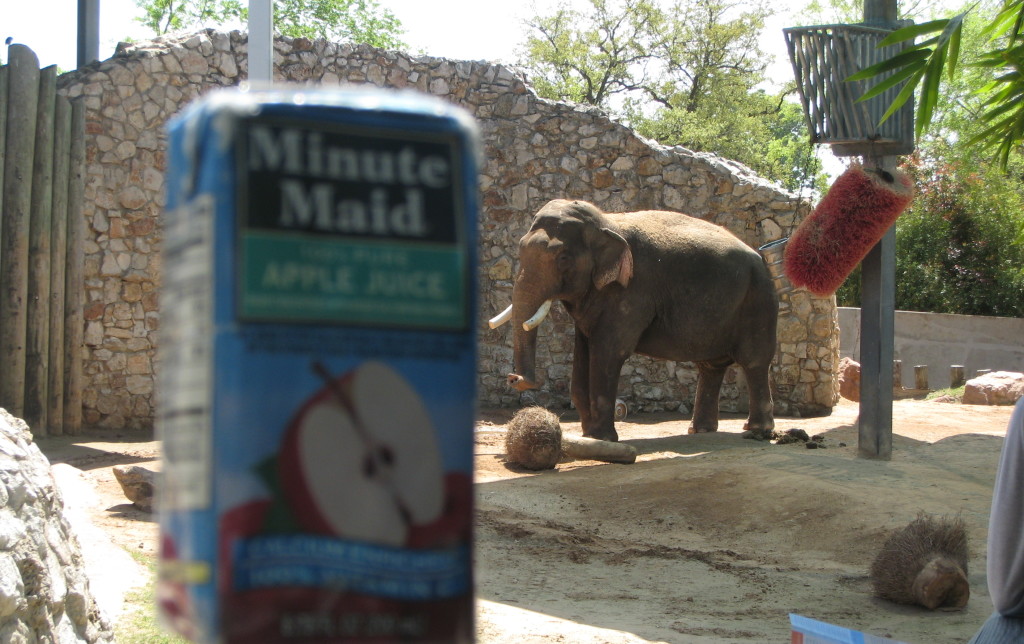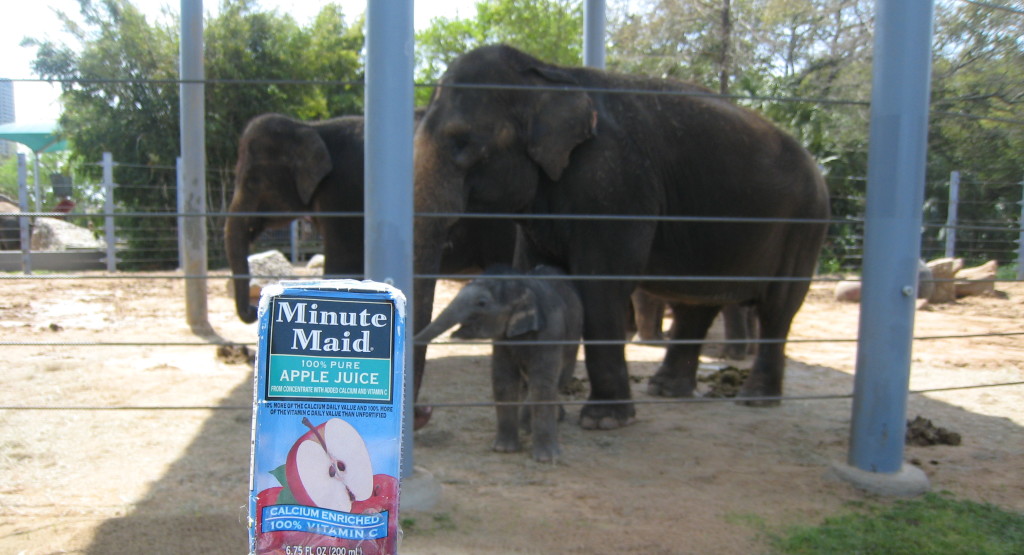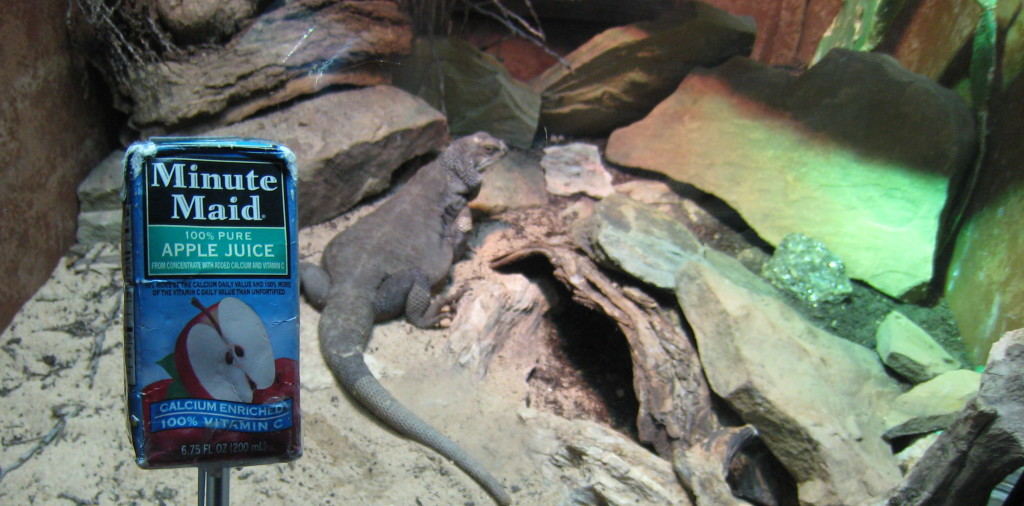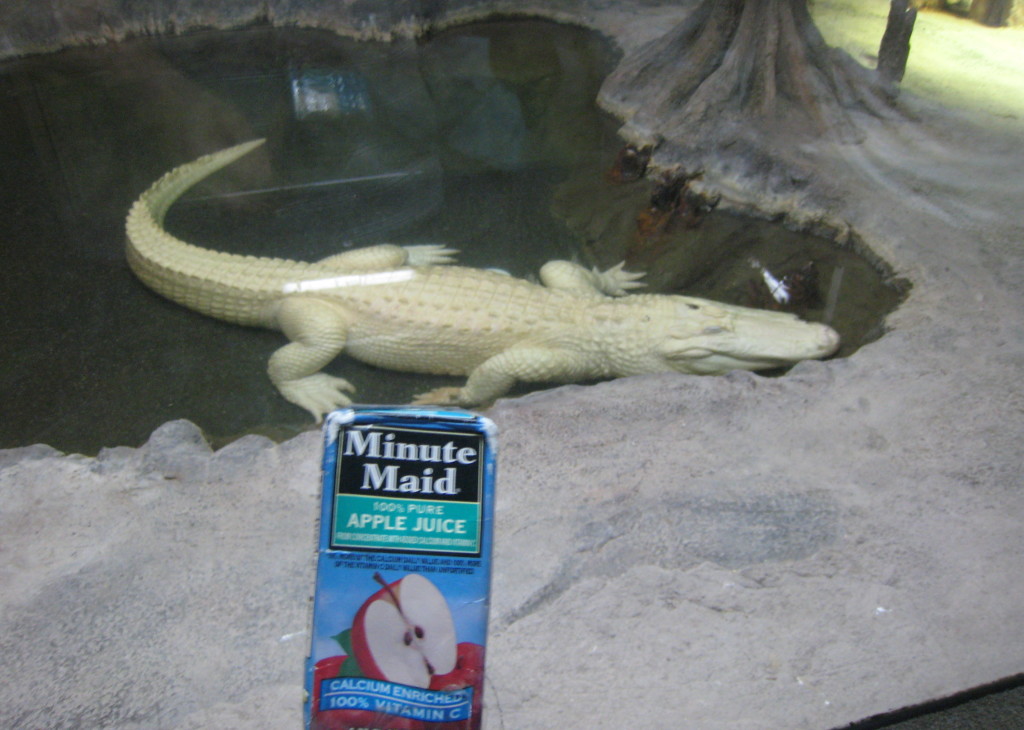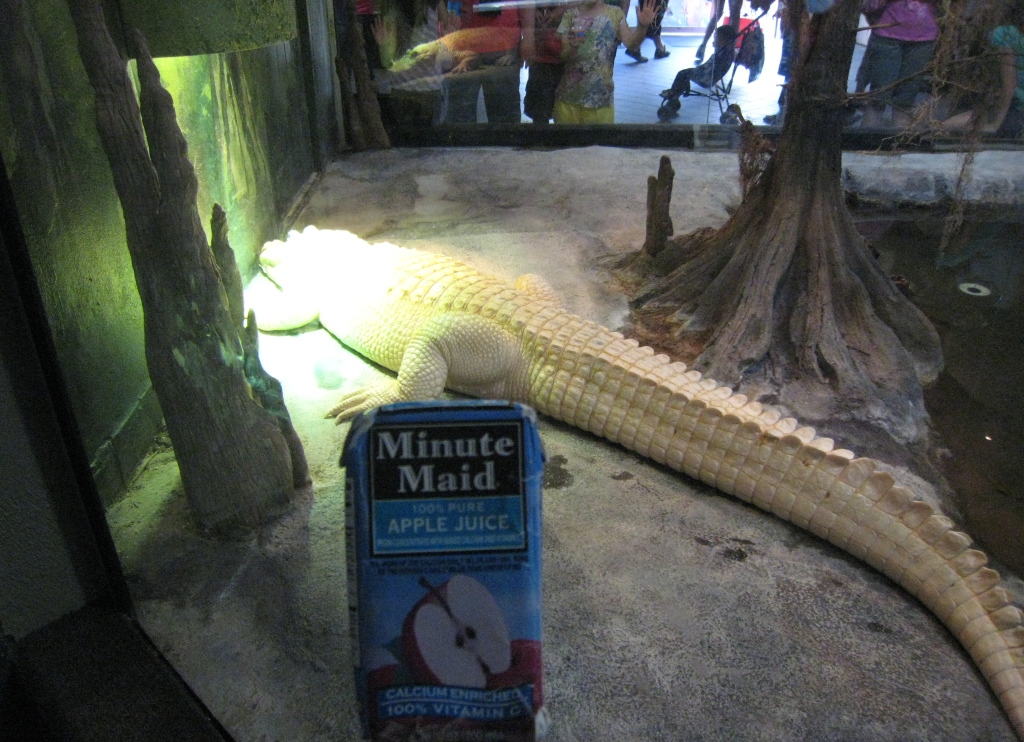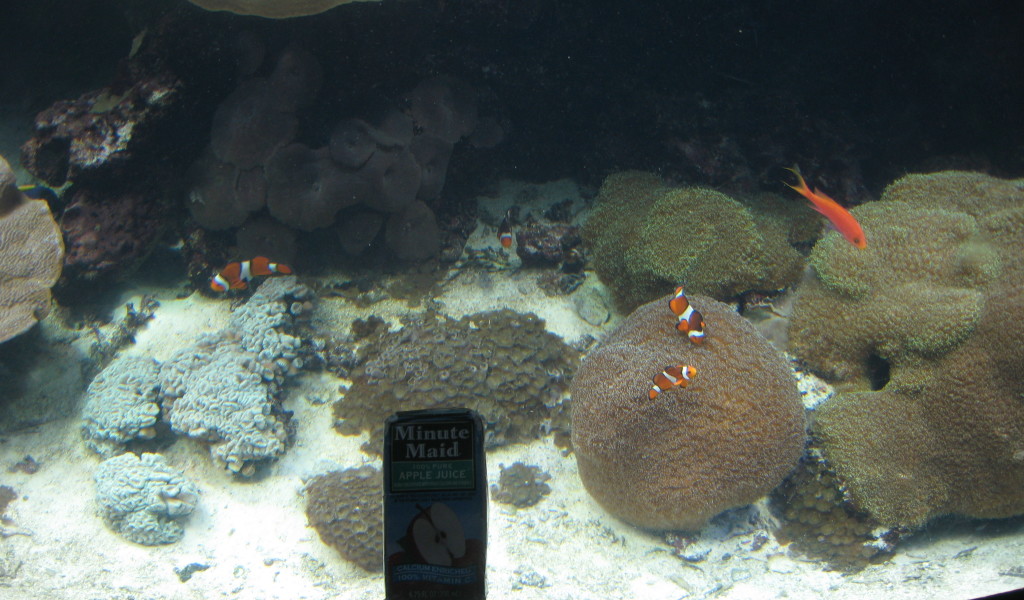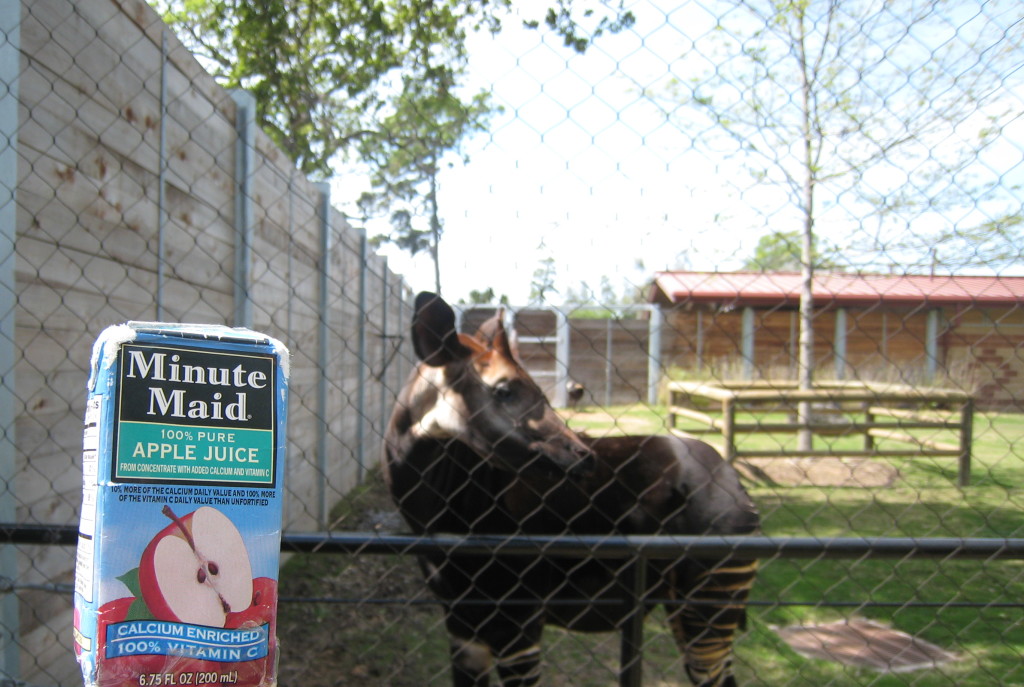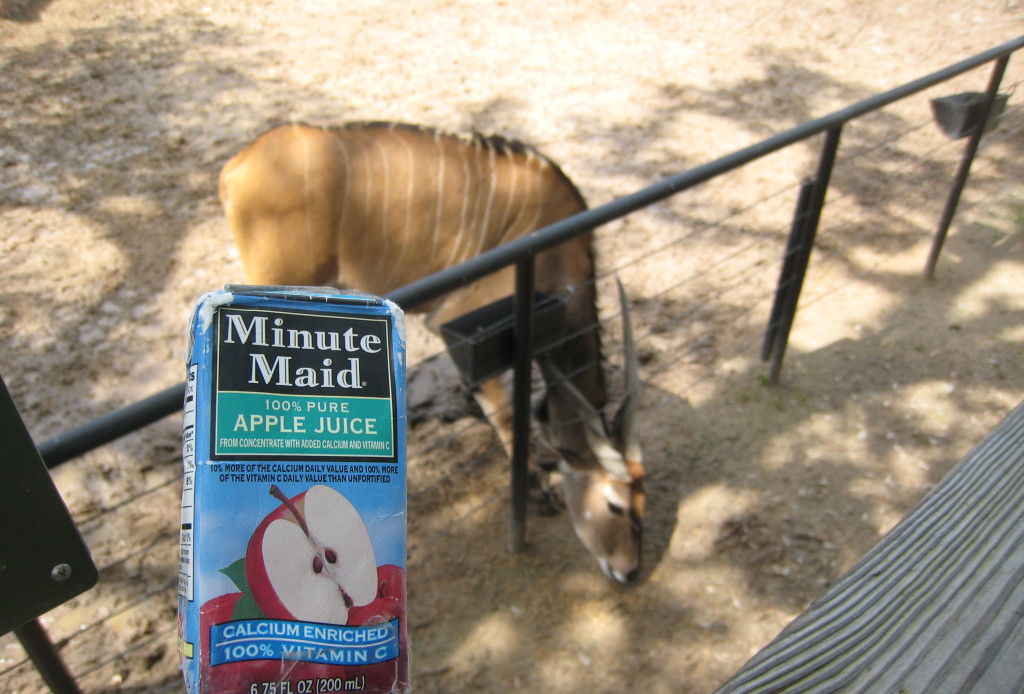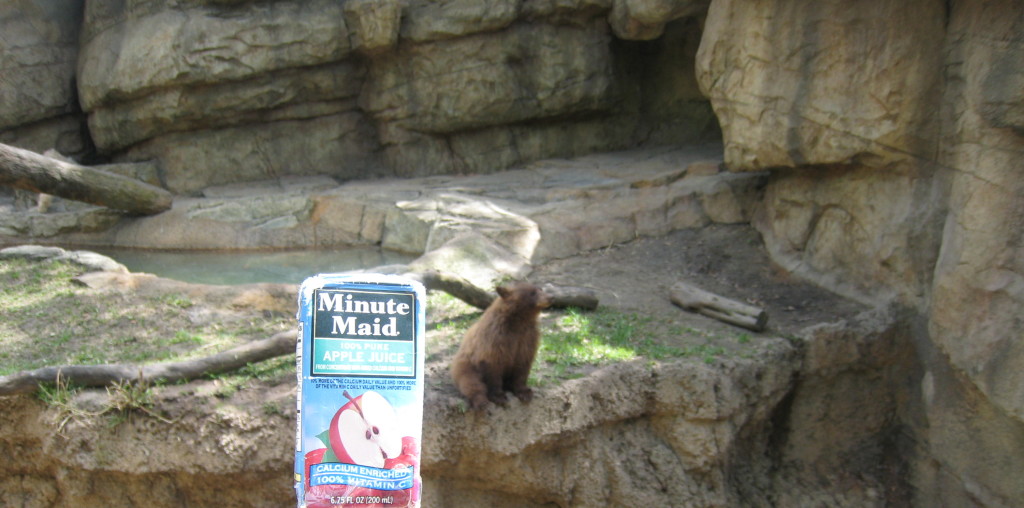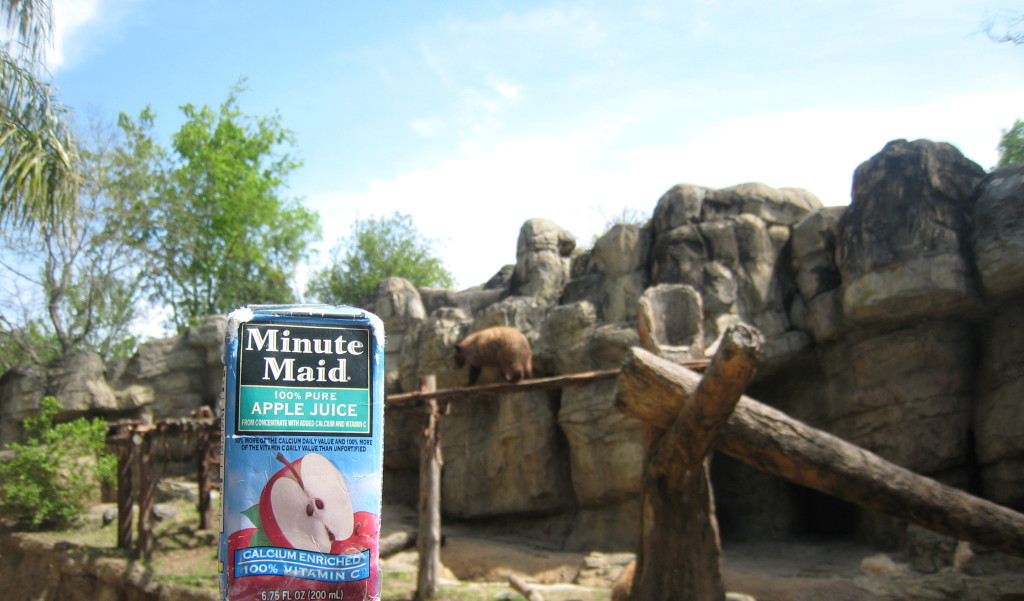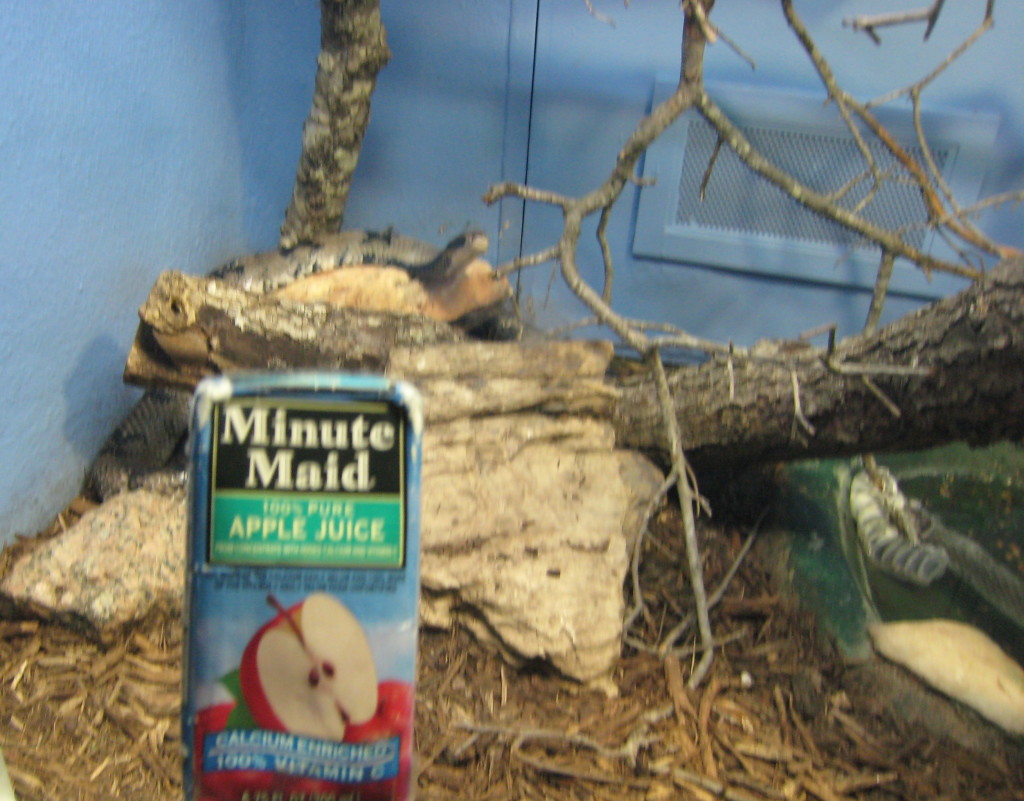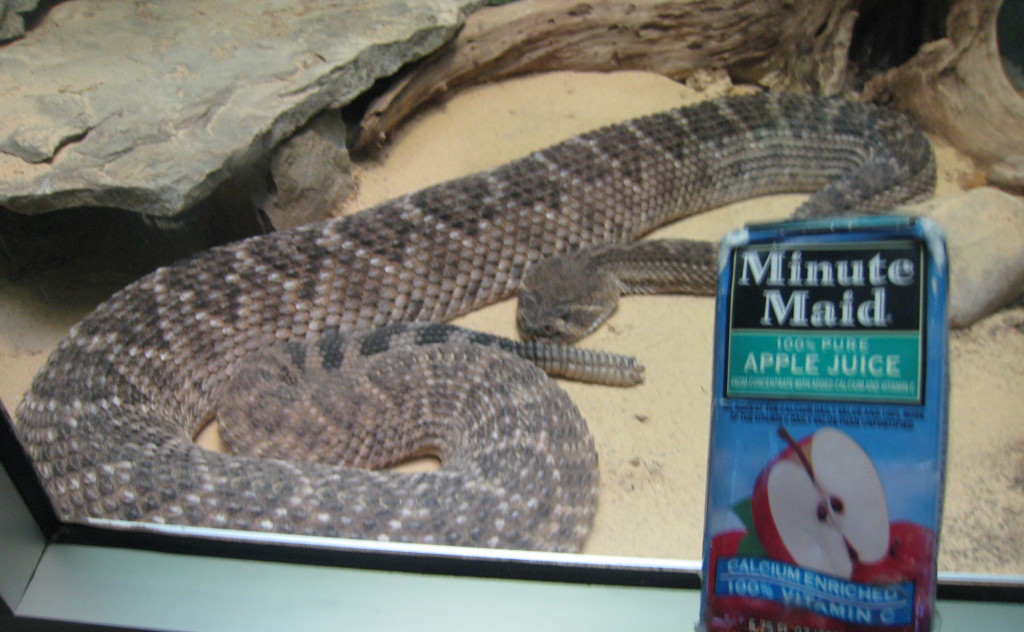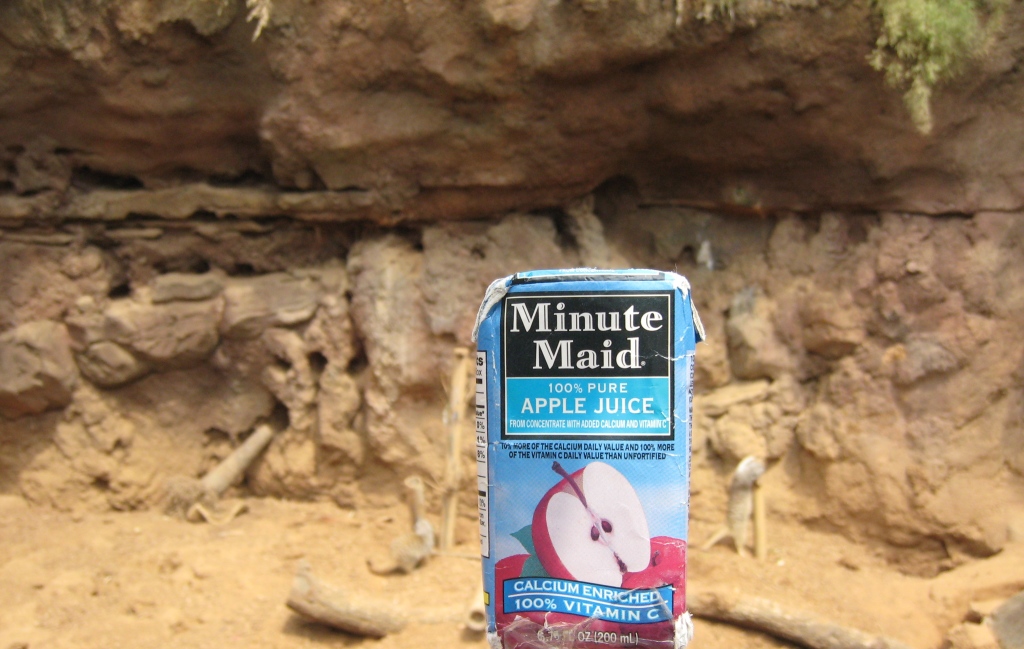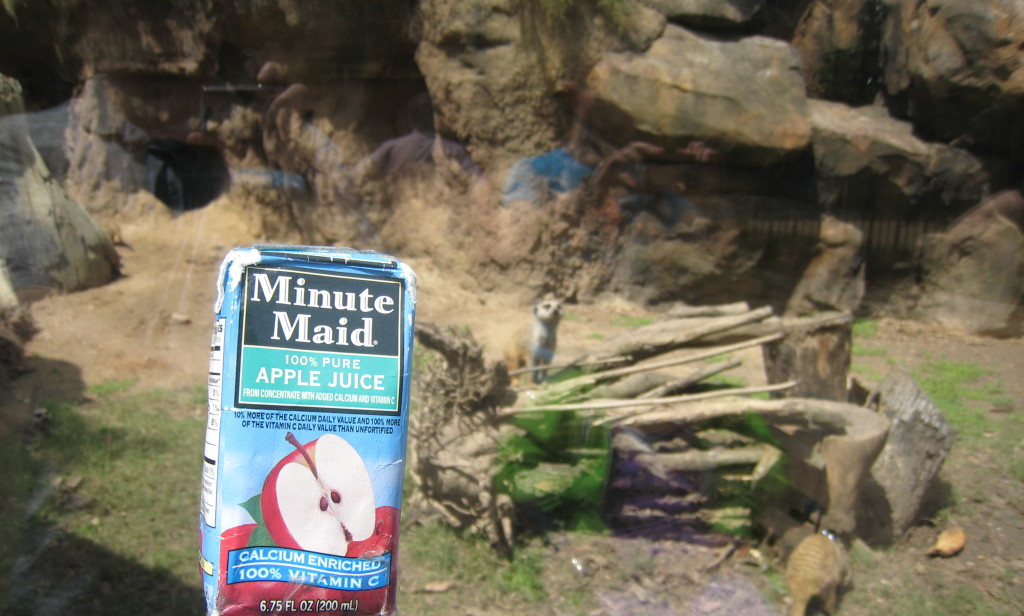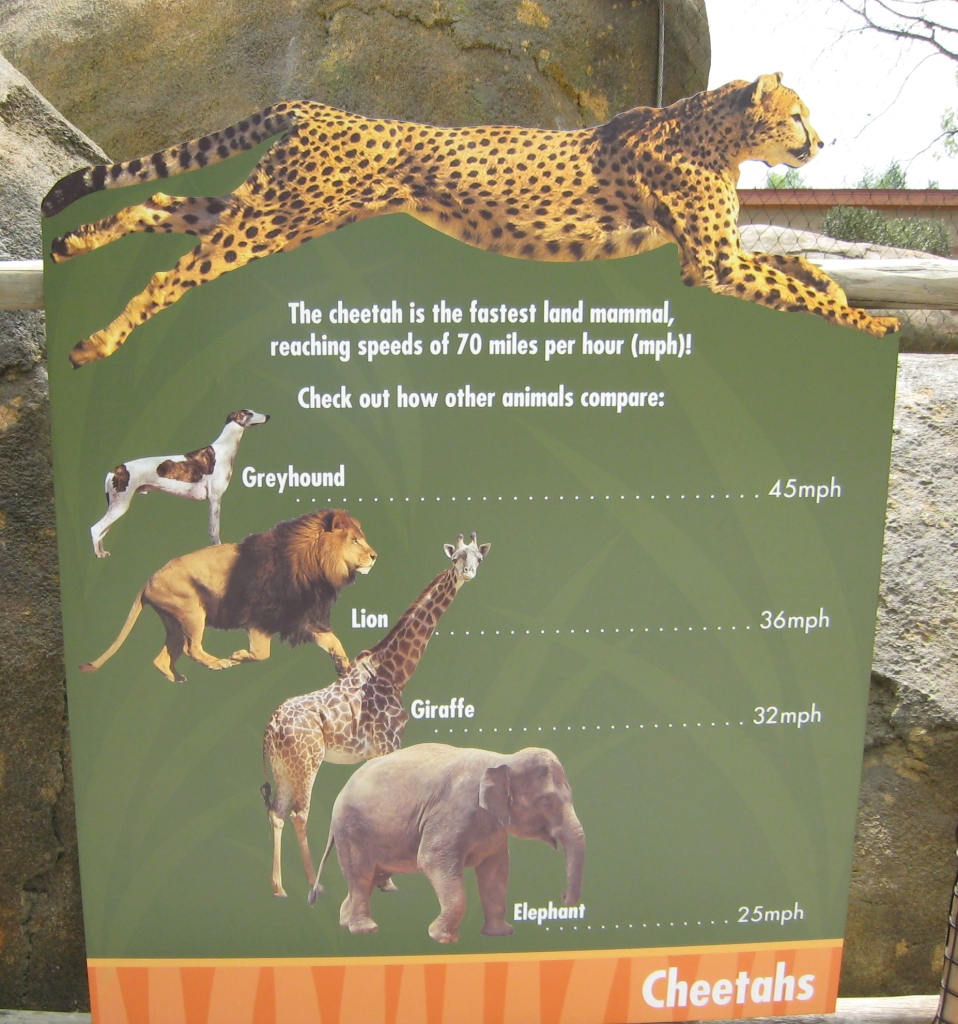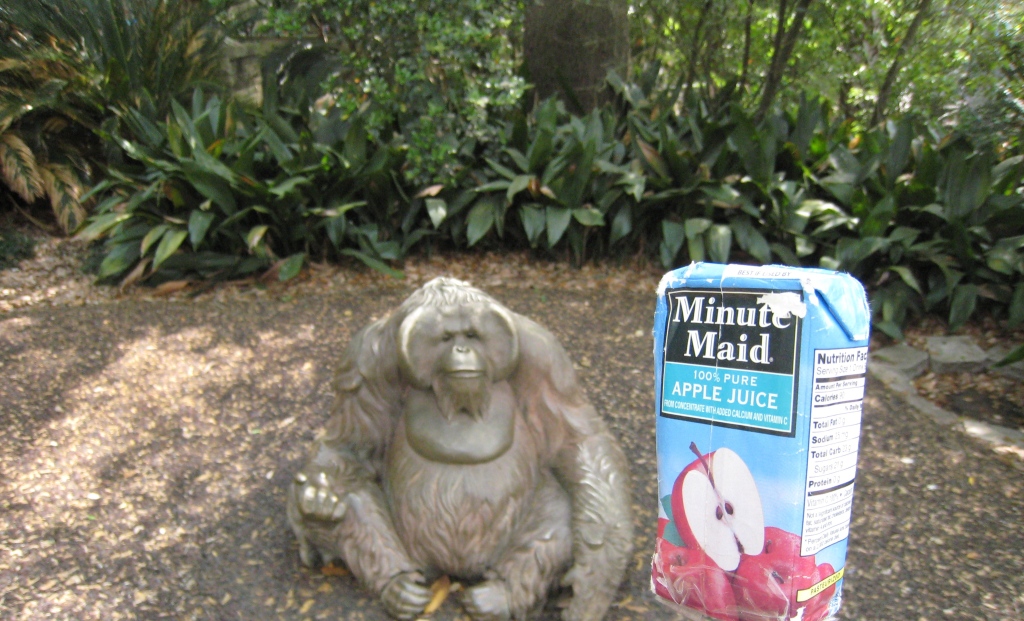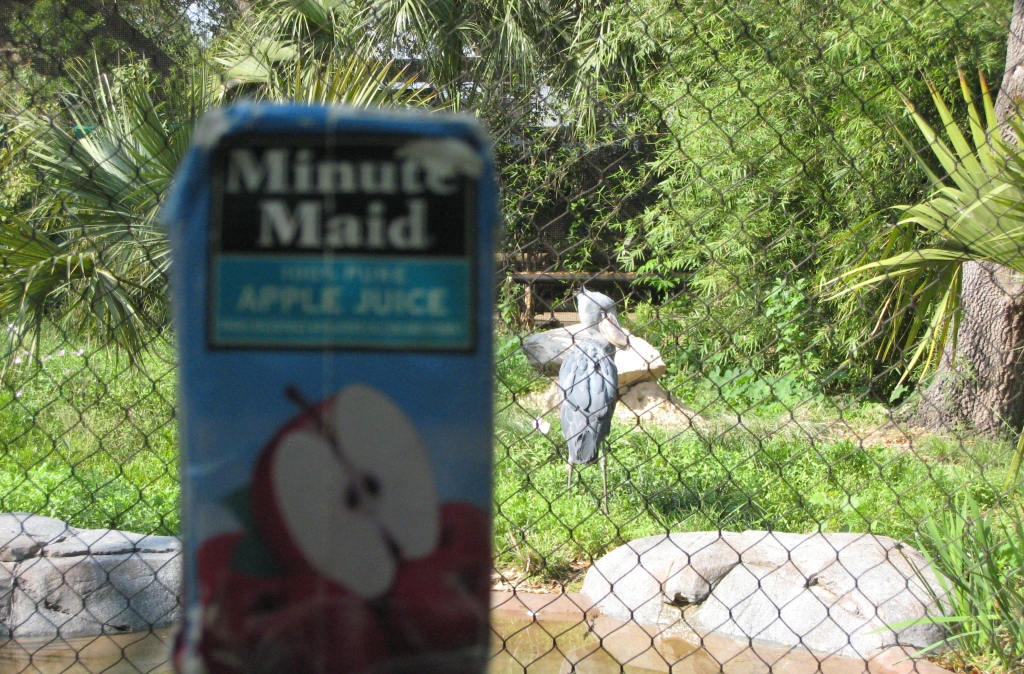Maid Appleton @ the Houston Zoo
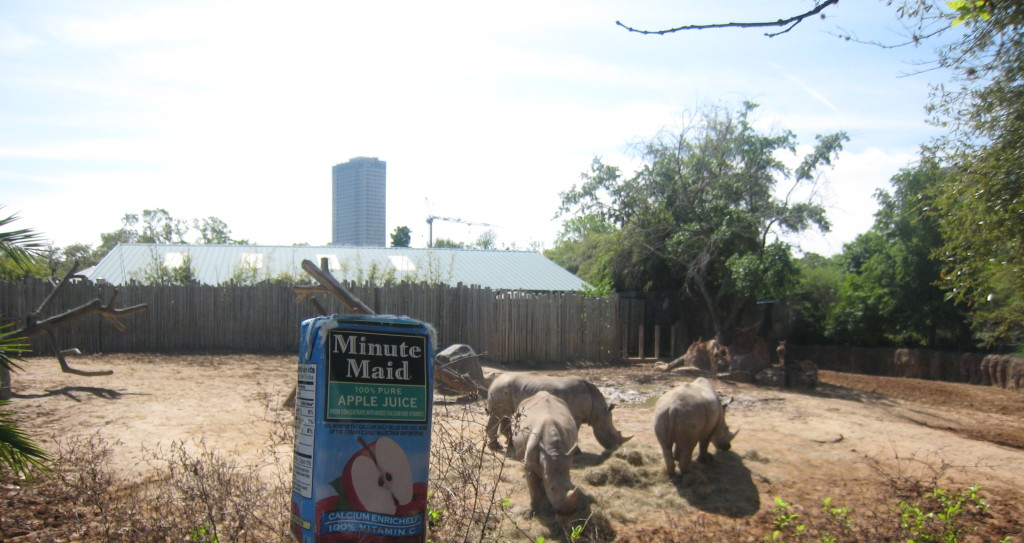
“Who Cares About Endangered Rhinos? – We Do. Displaying live animals is the most effective way of inspiring people to support the conservation of critically endangered rhinos around the world. A secondary reason for keeping live rhinos is to have an ‘insurance’ population in case something catastrophic happens to the wild population.” “Where do these rhinos come from? A wildlife park in Africa. These rhinos come from South Africa’s Kruger National Park. The South African National Park Service (SANParks) donated them to the Houston Zoo. Kruger National Park’s conservation program is so effective that more rhinos are born there than the park’s natural habitat can support. So, to manage Kruger’s rhino population, some of the animals are humanely captured and acclimated to life in wildlife parks and zoos.”
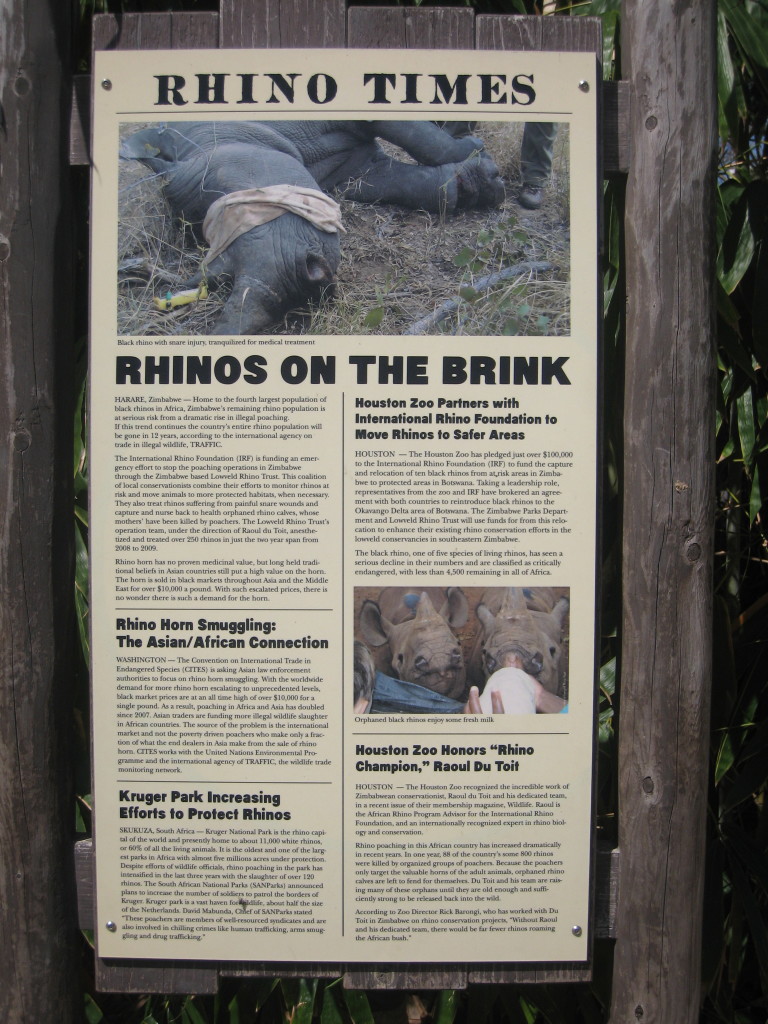
“Rhino Times ~ Rhinos on the Brink | Rhino Horn Smuggling: The Asian/African Connection | Kruger Park Increasing Efforts to Protect Rhinos | Houston Zoo Partners with International Rhino Foundation to Move Rhinos to Safer Areas | Houston Zoo Honors ‘Rhino Champion,’ Raoul Du Toit”
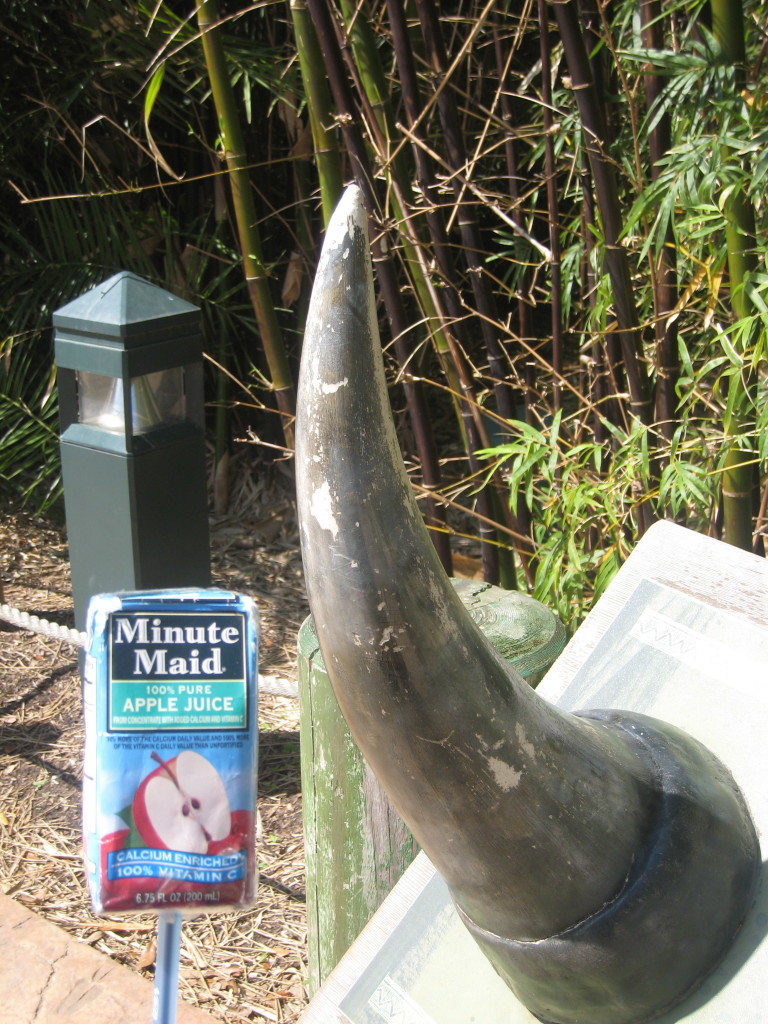
“Under veterinary supervision, horns of sedated rhinos are painlessly removed. This makes the animals less attractive to poachers.” ~ Rhino Horns: Remarkable Adaptations/Tragic Commodities ~ The Best Defense: Rhinos use their horns as weapons to fend off predators, and males use them for sparring when competing for females and territory. Add humans to the picture and this prominent adaptation, evolved from compressed hair, turns into a tragic flaw. | Rhino Horn Tonic: Making a Killing – The only reason people hunt rhinos is for rhino horn. In Asia, the horns are ground up, boiled down, and sold as an herbal medicine called ‘An Gong Niu Huang Wan.’ Tragically, this popular Chinese tonic, used to treat fever, continues to be sold internationally and on in the Internet. Rhino horn is made of keratin – the protein that forms hair and fingernails. Like snake oil, sold long ago, keratin has no proven medicinal value. People who use it for medicine might as well just chew their fingernails.”
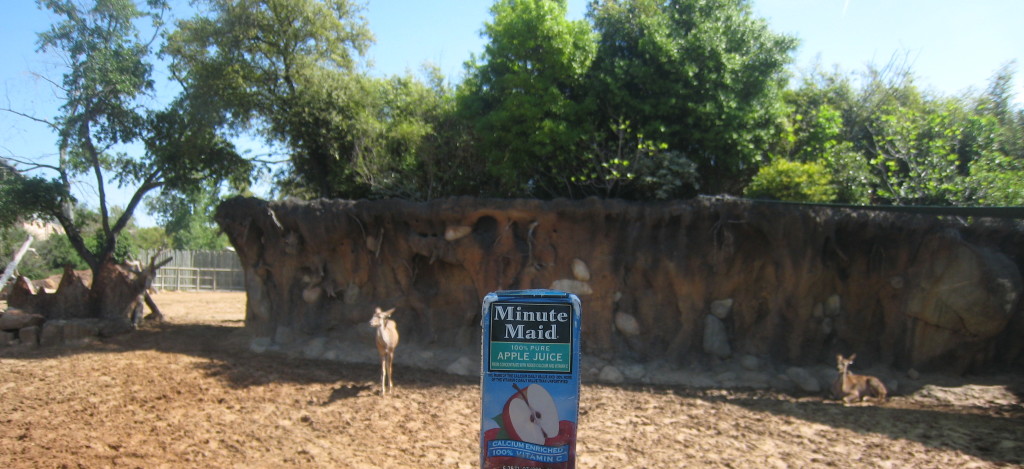
“What’s that on your head? The Greater Kudu has the longest horns of any of the antelope species, measuring up to six feet along the curve! The second tallest of the African Antelope (after the Eland) and weighing up to 575 pounds, Kudu are particularly handsome animals with striking patterns of white body stripes and prominent nose chevrons. ~ The White Rhinos and Greater Kudu that you see sharing space here at the Zoo represent a scene not unlike what might be viewed in their native southern Africa habitats, where multiple species may graze together or congregate around waterholes.”
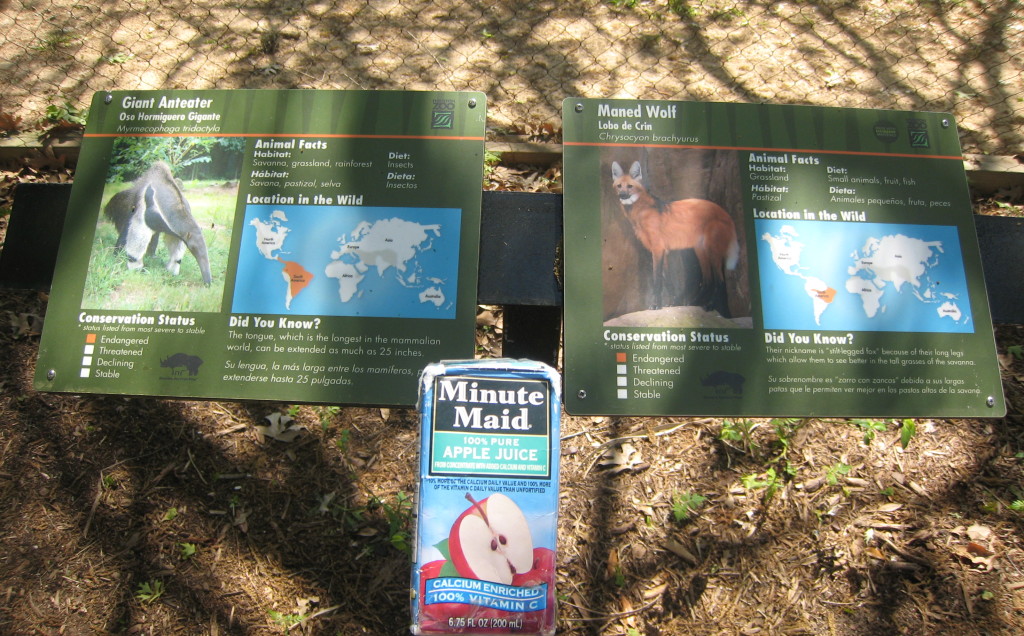
“Maned Wolf, Lobo de Crin (Chrysocyon brachyrus) – Did you know? Their nickname is ‘stilt-legged fox’ because of their long legs which allow them to see better in the tall grasses of the savanna. | Animal Facts – Habitat: Grassland; Diet: Small animals, fruit, fish | Conservation Status: Endangered.”

“Giant Anteater – Oso Hormiguero Gigante (Myrmecophaga tridactyla) – Did you know? The tongue, which is the longest in the mammalian world, can be extended as much as 25 inches. Animal Facts — Habitat: Savanna, grassland, rainforest; Diet: Insects; Conservation Status: Endangered.”
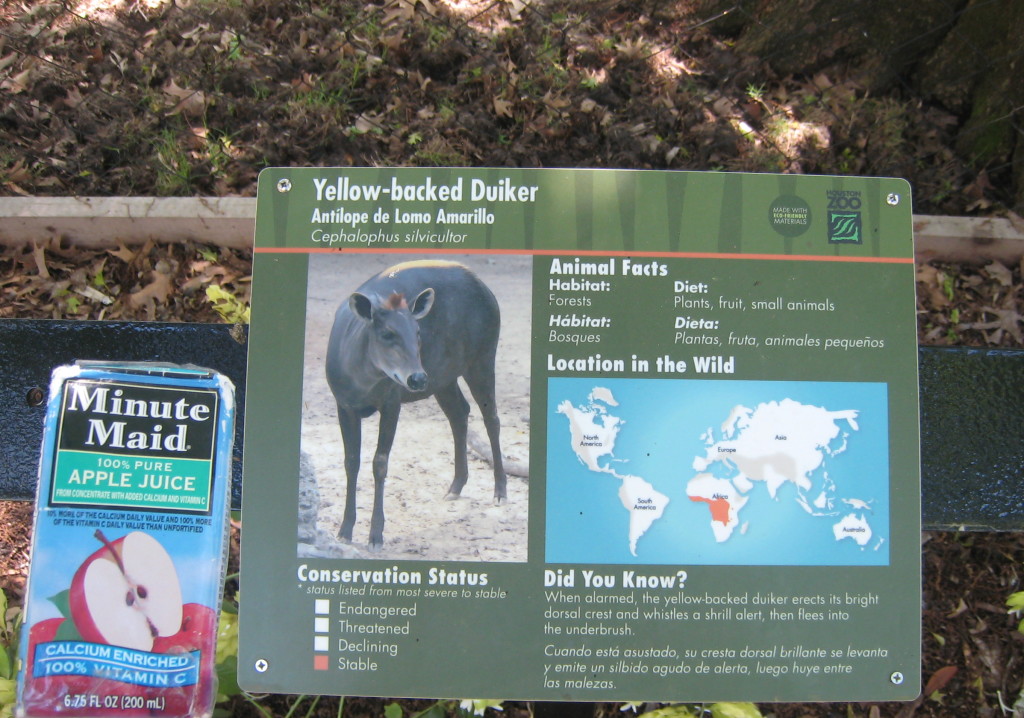
“Yellow-backed Duiker, Antilope de Lomo Amarillo (Cephalophus silvicultor) – Did you know? When alarmed, the yellow-backed duiker erects its bright dorsal crest and whistles a shrill alert, then flees into the underbrush. | Animal Facts – Habitat: Forests; Diet: Plants, fruit, small animals.”
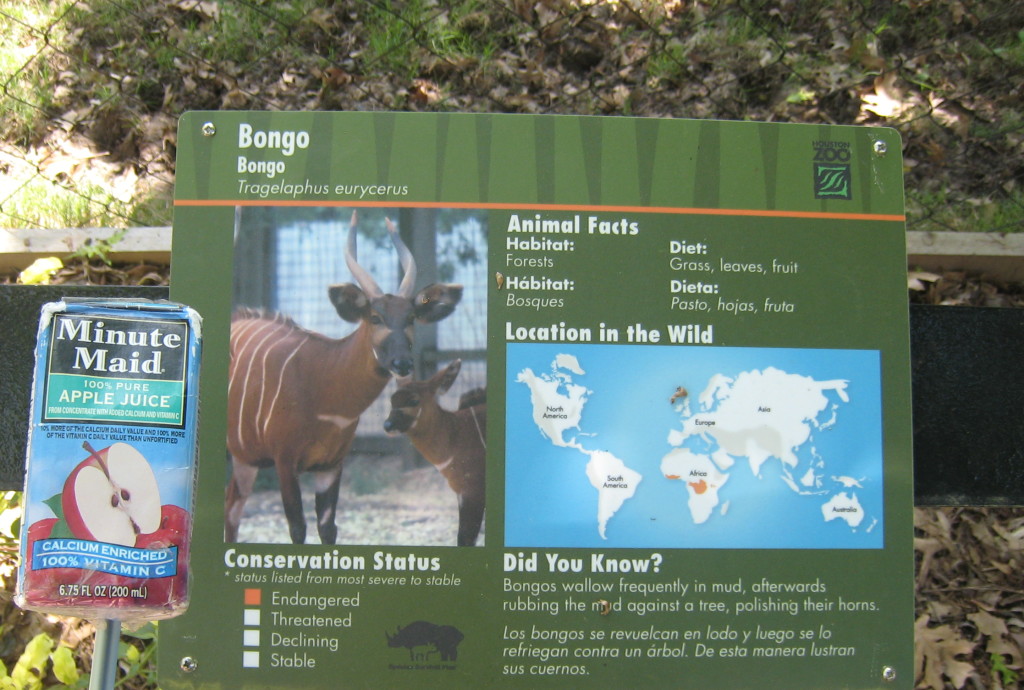
“Bongo (Tragelaphus eurycerus) – Did you know? Bongos wallow frequently in mud, afterwards rubbing the mud against a tree, polishing their horns. | Animal Facts – Habitat: Forests; Diet: Grass, leaves, fruit; Conservation Status: Endangered.”
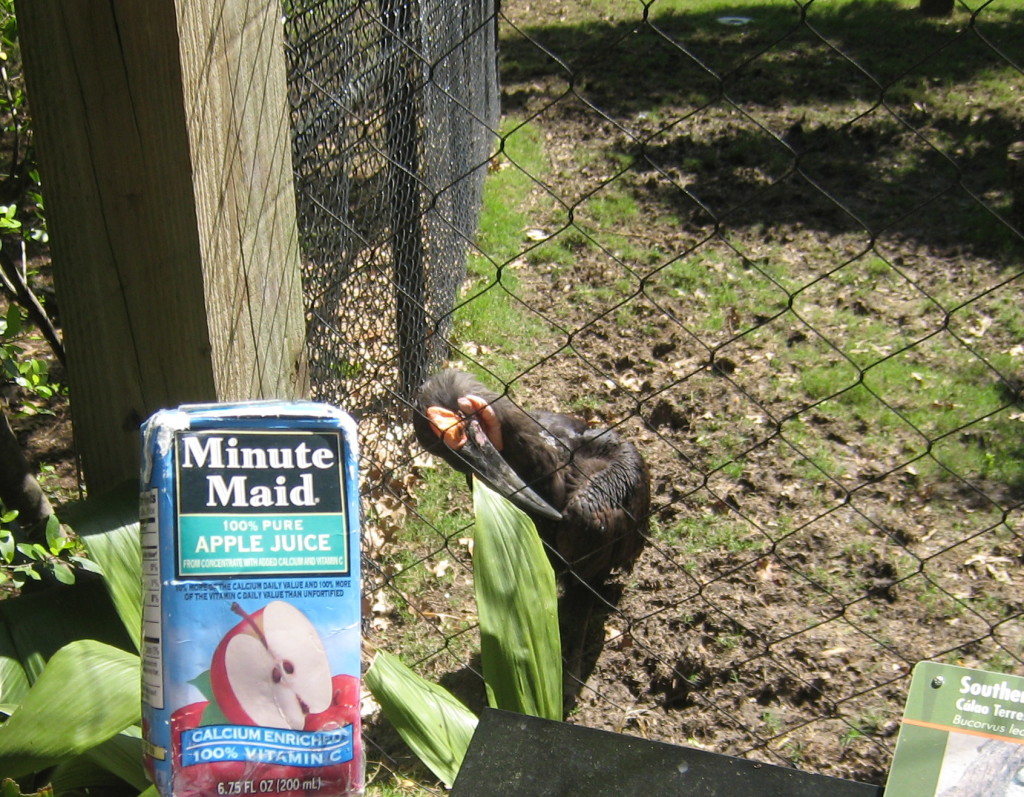
“Southern Ground Hornbill, Calao Terrestre Sureno (Bucorvus leadbeateri) – Did you know? They are notable for their long eye lashes and throat skin which is flexible and inflates when making guttural calls. | Animal Facts – Habitat: Savanna, grassland, woodland; Diet: Small animals; Conservation Status: Stable.”

“Grizzly Bear ~ Boomer and Bailey – Boomer and Bailey are 2007 editions to the Houston Zoo, confiscated by a county sheriff from the barn of a private individual, where they lived in small cages. The zoo assisted the Houston SPCA with the transport and placement of 11 bears and 2 tigers, a story that was featured on Animal Planet’s ‘Animal Cops Houston.’ With some renovations to an empty exhibit, the zoo was able to provide a happy retirement home for these two special bears. — Bear-ly Holding On-In the 1800s there may have been 100,000 grizzlies in the Western U.S. Now there are probably fewer than 1,000, mostly in Yellowstone and Glacier National Parks. The parts of North America from which the bear has been eliminated correspond closely to areas of intensive ranching and grazing.”

“Grizzly Bear, Oso Pardo (Ursus arctos horribilis) – Did you know? Grizzly bears have excellent fishing skills. Their population has drastically declined from 100,000 to 1,000 in the past 200 years in the continental United States. | Animal Facts – Habitat: Forests, mountains; Diet: Plants, fruit, small animals; Conservation Status: Threatened.”
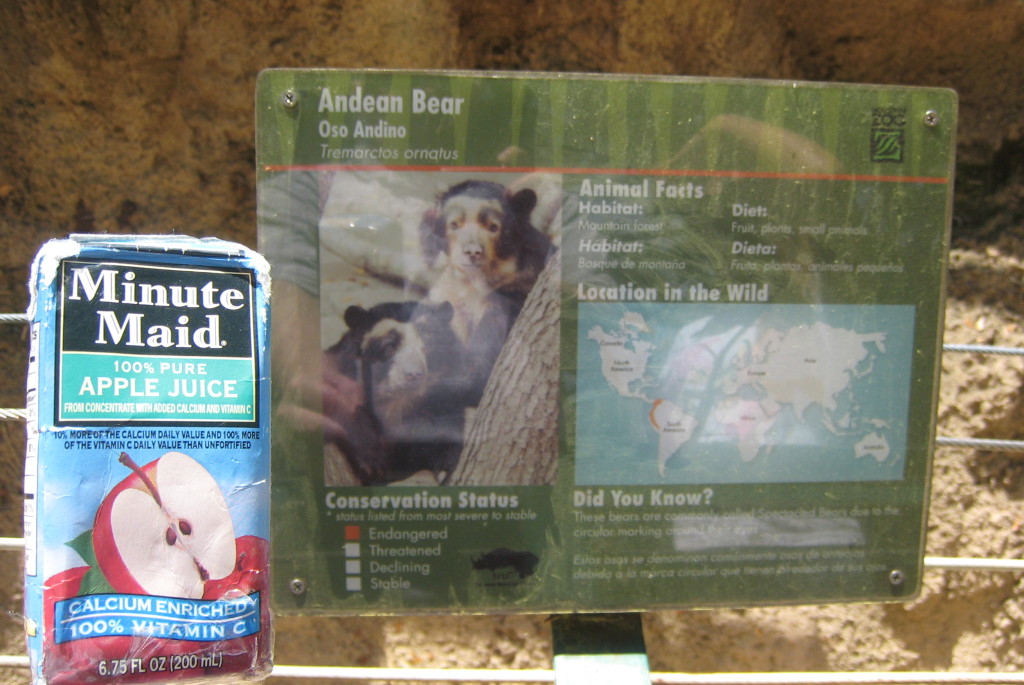
“Andean Bear, Oso Andino (Tremarctos ornatus) – Did you know? These bears are commonly called ‘Spectacled Bears’ due to the circular marking around their eyes. | Animal Facts ~ Habitat: Mountain forest; Diet: Fruit, plants, small animals
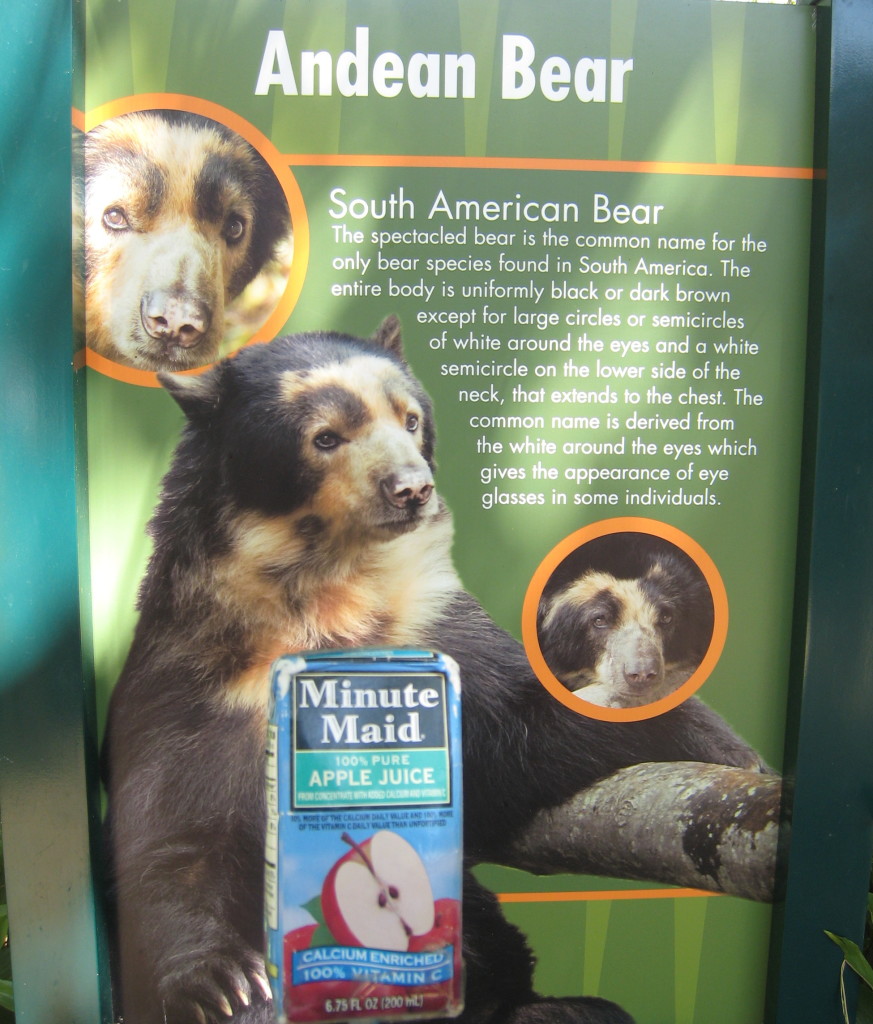
“Andean Bear ~ South American Bear – The spectacled bear is the common name for the only bear species found in South America. The entire body is uniformly black or dark brown except for large circles or semicircles of white around the eyes and a white semicircle on the lower side of the neck, that extends to the chest. The common name is derived from the white around the eyes which gives the appearance of eye glasses in some individuals.”
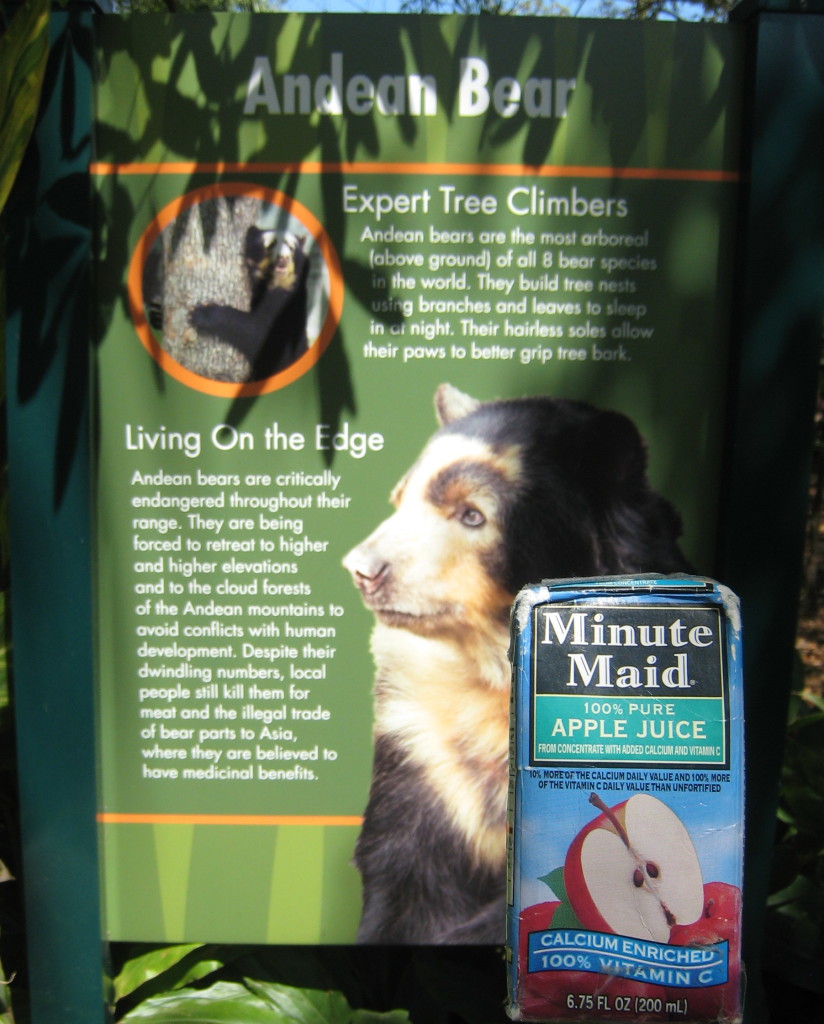
“Andean Bear ~ Expert Tree Climbers – Andean bears are the most arboreal (above ground) of all 8 bear species in the world. They build tree nests using branches and leaves to sleep in at night. Their hairless soles allow their paws to better grip tree bark. | Living On the Edge – Andean bears are critically endangered throughout their range. They are being forced to retreat to higher and higher elevations and to the cloud forests of the Andean mountains to avoid conflicts with human development. Despite their dwindling numbers, local people still kill them for meat and the illegal trade of bear parts to Asia, where they are believed to have medicinal benefits.”
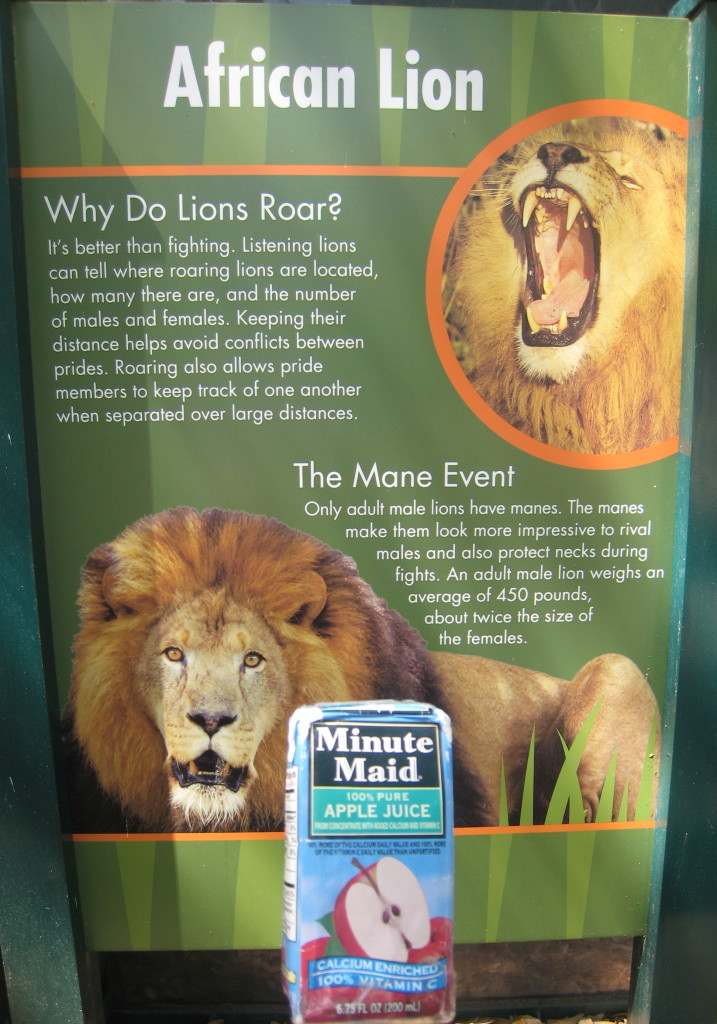
“African Lion ~ Why Do Lions Roar? It’s better than fighting. Listening lions can tell where roaring lions are located, how many there are, and the number of males and females. Keeping their distance helps avoid conflicts between prides. Roaring also allows pride members to keep track of one another when separated over large distances. | The Mane Event – Only adult male lions have manes. The manes make them look more impressive to rival males and also protect necks during fights. An adult male lion weighs an average of 450 pounds, about twice the size of the females.”
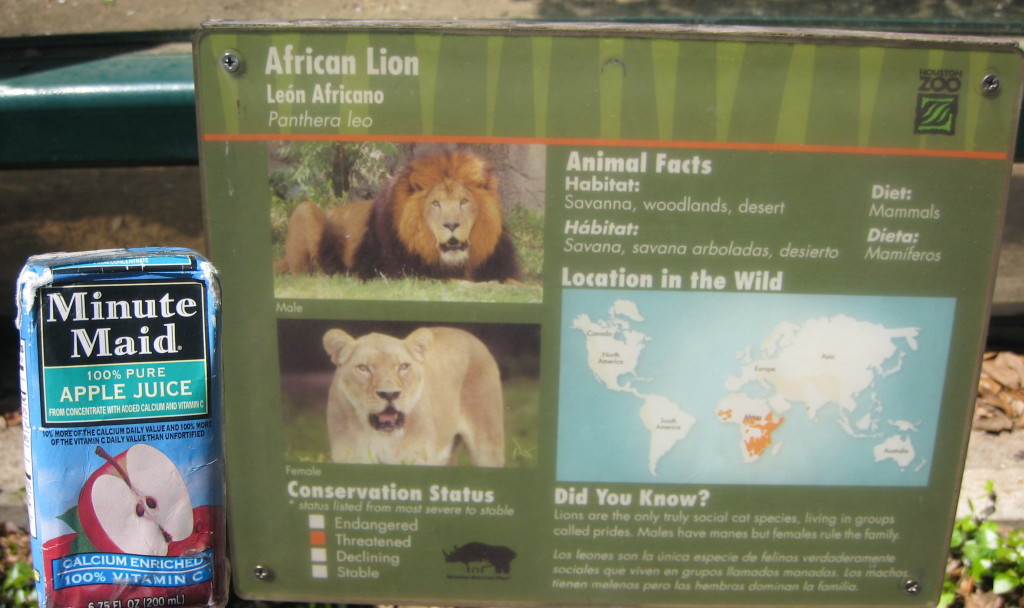
“African Lion, Leon Africano (Panthera leo) – Did you know? Lions are the only truly social cat species, living in groups called prides. Males have manes but females rule the family. | Animal Facts – Habitat: Savanna, woodlands, desert; Diet: Mammals; Conservation Status: Threatened.”

“Leopard ~ Expert Hunters – Hunting is accomplished mainly by stalking and sneaking up on prey. Leopards are powerful enough to take down and kill large antelope weighing three times their weight. Two of their favorite prey items in Africa are baboons and warthogs. Food is frequently stored in trees to keep it away from lions and hyenas. Leopards are often seen resting high in tree canopies with their feet – and the feet of their prey – dangling from a limb. | Different Spots for Different Cats – Leopards are similar in appearance to jaguars, but are slightly smaller with a more slender frame. Both have spotted coats, but leopards have a compressed series of black and brown rosettes and lack additional spots inside these circular patterns. These coat markings make the leopard very difficult to detect in tall grass or trees. Black leopards are rarely seen in the wild. If you look closely at the black leopard’s coat, you can make out its spots.”
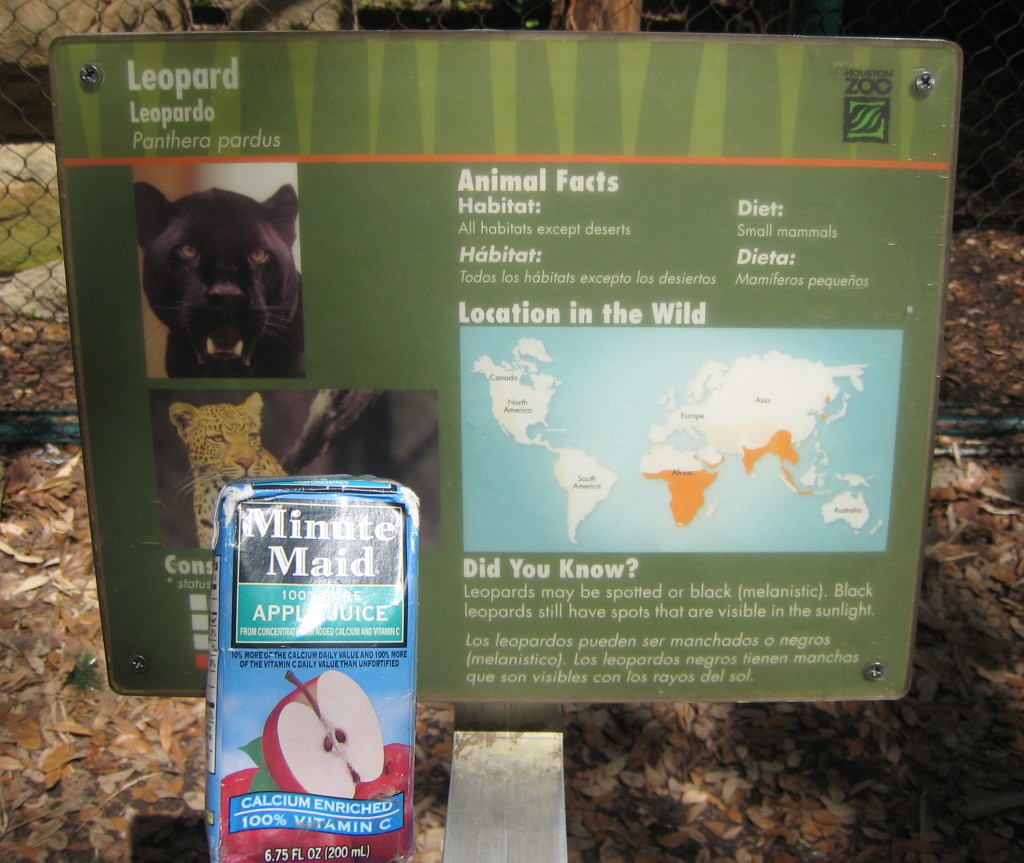
“Leopard, Leopardo (Panthera pardus) – Did you know? Leopards may be spotted or black (melanistic). Black leopards still have spots that are visible in the sunlight. | Animal Facts – Habitat: All habitats except deserts; Diet: Small mammals; Conservation Status: Stable”
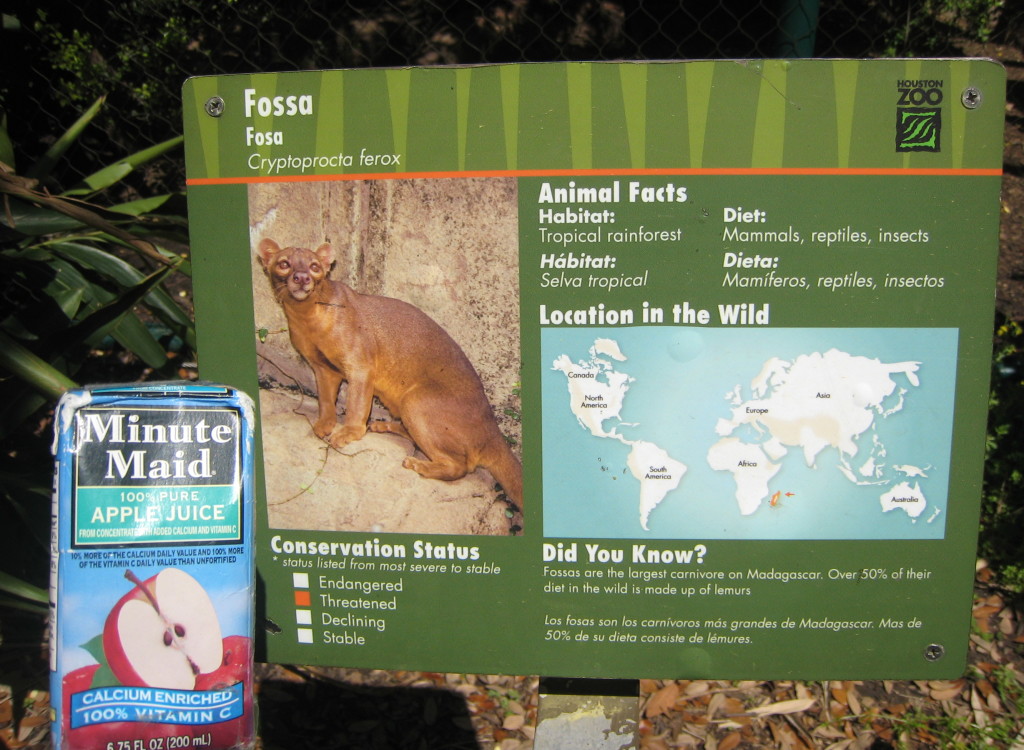
“Fossa, Fosa (Cryptoprocta ferox) – Did you know? Fossas are the largest carnivore on Madagascar. Over 50% of their diet in the wild is made up of lemurs. | Animal Facts – Habitat: Tropical rainforest; Diet: Mammals, reptiles, insects; Conservation Status: Threatened”
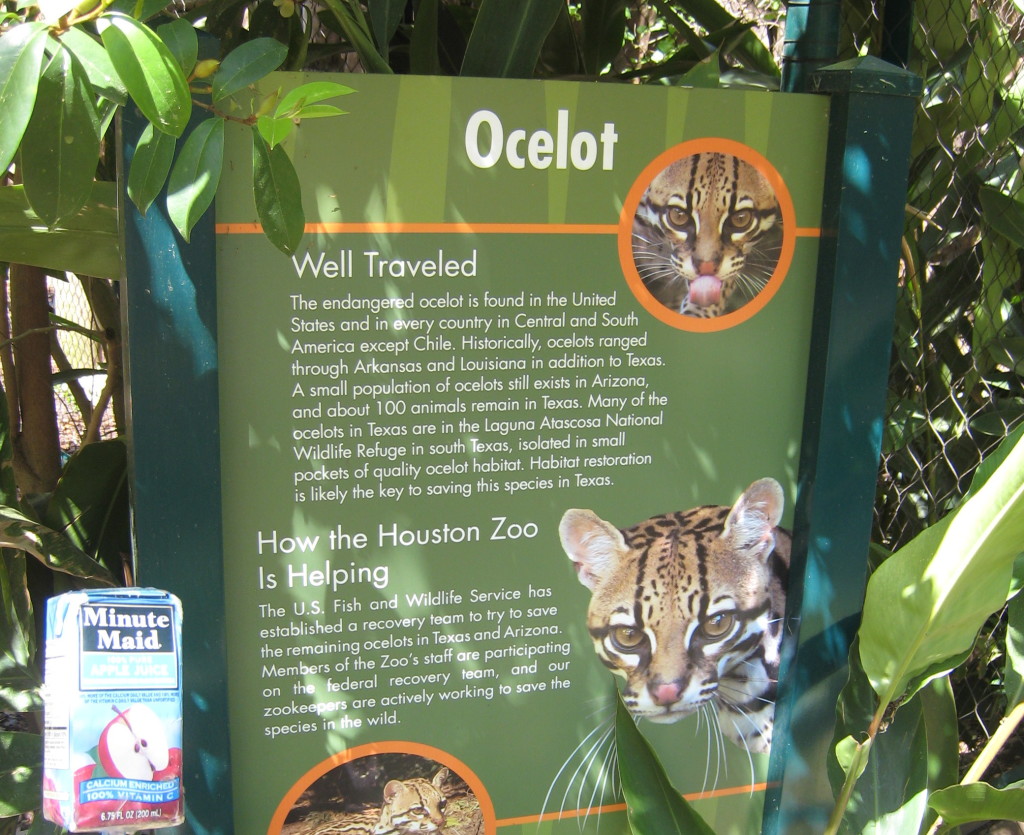
“Ocelot ~ Well Traveled – The endangered ocelot is found in the United States and in every country in Central and South America except Chile. Historically, ocelots ranged through Arkansas and Louisiana in addition to Texas. A small population of ocelots still exists in Arizona, and about 100 animals remain in Texas. Many of the ocelots in Texas are in the Laguna Atascosa National Wildlife Refuge in south Texas, isolated in small pockets of quality ocelot habitat. Habitat restoration is likely the key to saving this species in Texas. | How the Houston Zoo Is Helping – The U.S. Fish and Wildlife Service has established a recovery team to try to save the remaining ocelots in Texas and Arizona. Members of the Zoo’s staff are participating on the federal recovery team, and our zookeepers are actively working to save the species in the wild.”

“Caracal, Lince Africano (Caracal caracal caracal) – Did you know? Caracals are such quick hunters they can catch birds out of the air with their paws. | Animal Facts – Habitat: Forest, grassland; Diet: Small mammals, birds; Conservation Status: Stable”

“Clouded Leopard, Leopardo Nublado (Neofelis nebuloa) – Did you know? They are named for their spots which resemble clouds and are excellent tree climbers who can run head first down trees. | Animal Facts – Habitat: Forests; Diet: Birds, mammals; Conservation Status: Declining”

“Jaguar (Panthera onca) – Did you know? Jaguars are the largest cats in the Americas. The jaguar is the only big cat to kill their prey by crushing the skull with a bite. | Animal Facts – Habitat: Grassland, forest; Diet: Mammals, birds, fish; Conservation Status: Endangered”

“Jaguars ~ Adaptable Felines – Jaguars are very adaptable cats, living in a wide variety of habitats from deserts to rainforests. Historically, jaguars ranged through every country in the western hemisphere except Canada. Their current range is less than half that, due to habitat loss and conflict with humans. | Not Picky Eaters – Jaguars even like water and have been known to hunt turtles and dig up their eggs on beaches. They kill their prey in a unique manner for large cats, using their powerful jaws and large canines to pierce the skull. Jaguars eat a wide variety of prey that includes over 85 species of fish, birds, reptiles and mammals, ranging in size from rodents to deer.”
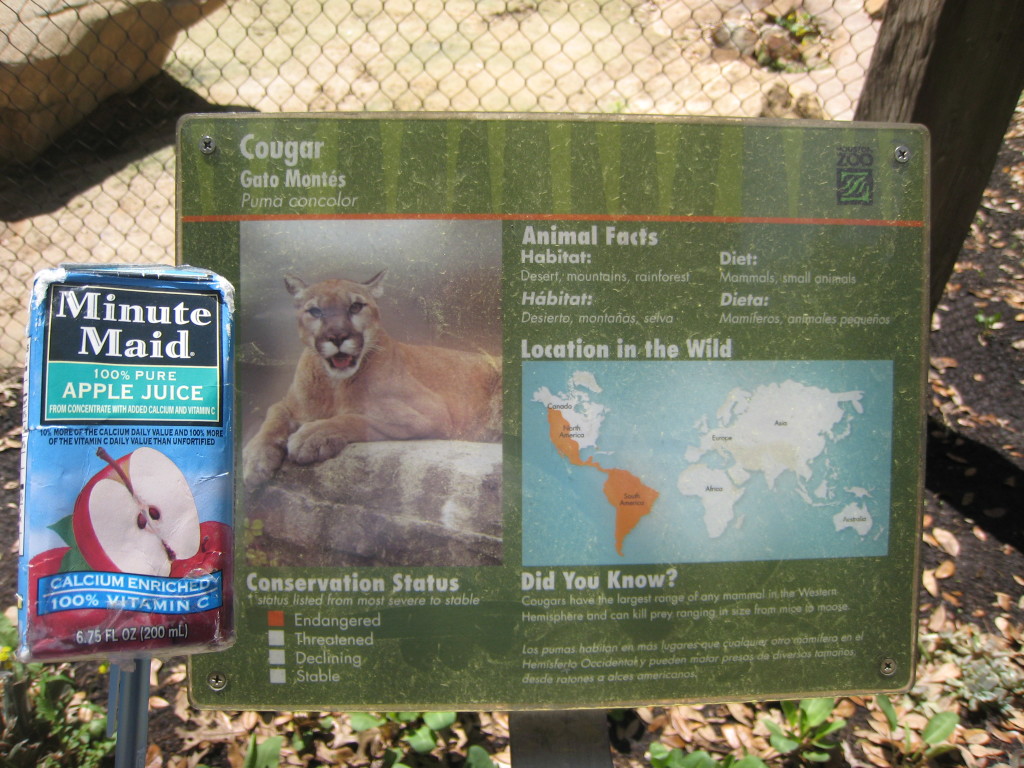
“Cougar, Gat Montes (Puma concolor) – Did you know? Cougars have the largest range of any mammal in the Western Hemisphere and can kill prey ranging in size from mice to moose. | Animal Facts – Habitat: Desert, mountain, rainforest; Diet: Mammals, small animals; Conservation Status: Endangered.”

“Malayan Tiger, Tigre de Malasia (Panthera tigris jacksoni) – Did you know? Tigers (all 6 subspecies) are the largest cat in the world and are critically endangered throughout their range of India to Siberia. | Animal Facts – Habitat: Forests; Diet: Mammals; Conservation Status: Endangered.”
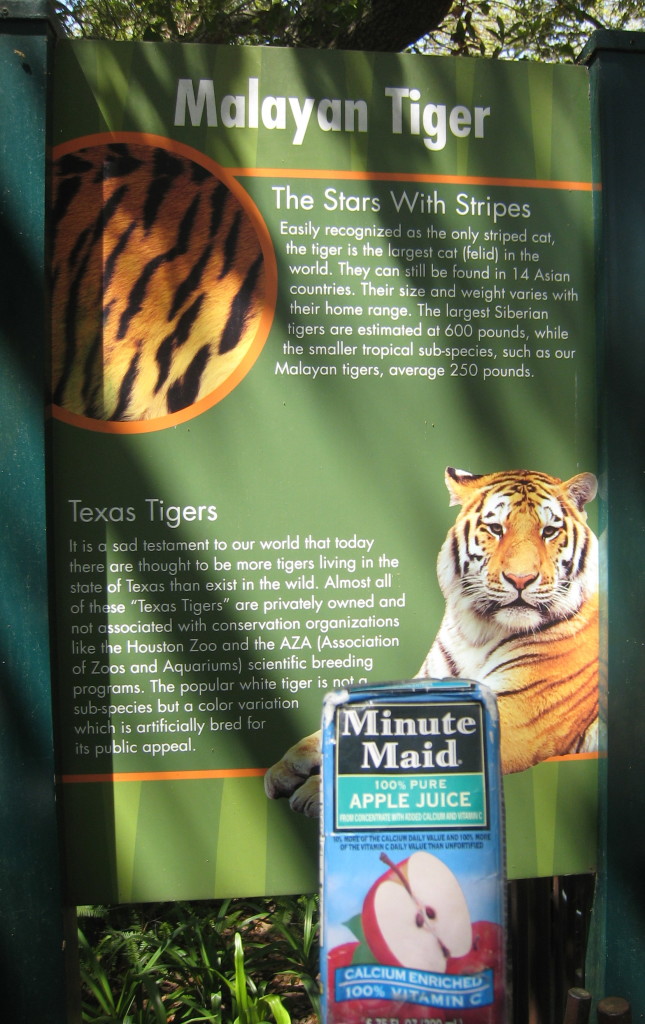
“Malayan Tiger ~ The Stars with Stripes – Easily recognized as the only striped cat, the tiger is the largest cat (felid) in the world. They can still be found in 14 Asian countries. Their size and weight varies with their home range. The largest Siberian tigers are estimated at 600 pounds, while the smaller tropical sub-species, such as our Malayan tigers, average 250 pounds. | Texas Tigers – It is a sad testament to our world that today there are thought to be more tigers living in the state of Texas than exist in the wild. Almost all of these ‘Texas Tigers’ are privately owned and not associated with conservation organizations like the Houston Zoo and the AZA (Association of Zoos and Aquariums) scientific breeding programs. The popular white tiger is not a sub-species but a color variation which is artificially bred for its public appeal.”

“African Lion ~ Jonathan ~ Jonathan is very vocal and enjoys attention. He like to roar early in the morning and late in the evening. A lion’s roar can be heard up to 5 miles! Jonathan is often found lounging on his back with his feet in the air. His favorite place to rest is in the shade of the large boulders. Lions have a keen sense of smell and their eyesight is 5 times better than a human’s.”
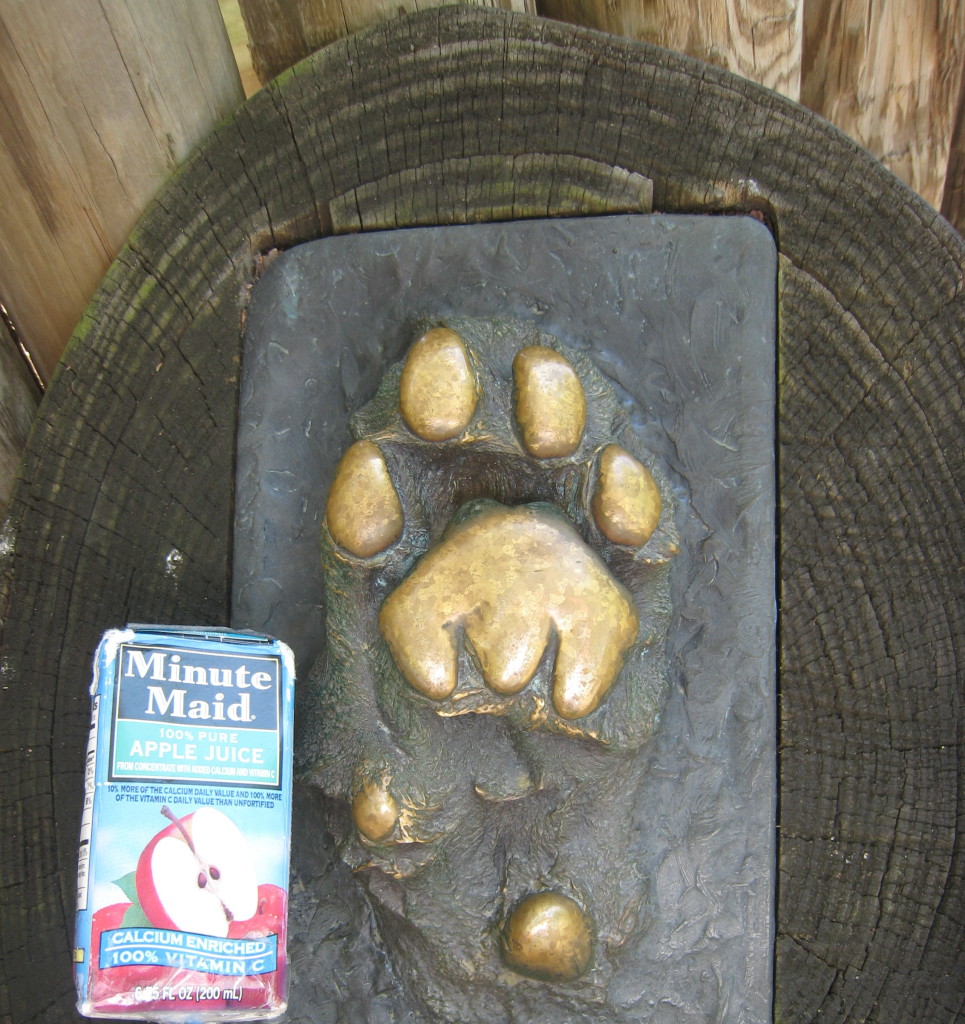
“Actual pawprint from ‘Celesto’, one of the Houston Zoo’s lionesses.” (Zarpa real de ‘Celesto’ uno de las leonesas del Zoologico de Houston)

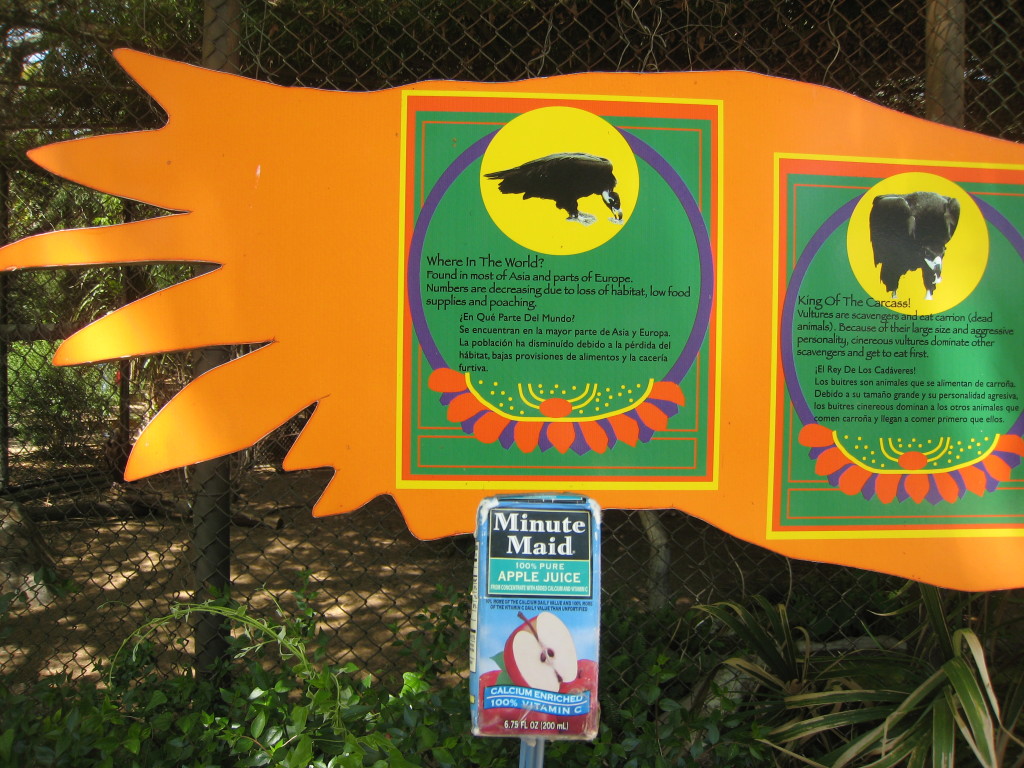

LEFT: “Where in the World? Found in most of Asia and parts of Europe. Numbers are decreasing due to loss of habitat, low food supplies and poaching.” MIDDLE: “King of the Carcass! Vultures are scavengers and eat carrion (dead animals). Because of their large size and aggressive personality, cinereous vultures dominate other scavengers and get to eat first.” RIGHT: “What does Cinereous mean? ‘Ashy’ or ‘sooty’ in color, refers to its grayish-brown feathers.”

MIDDLE: “Big Birds Need Big Nests! Young vultures need a large area to develop their wing muscles. Nests are often made of sticks, bark and animal skins. They are eight feet wide and give plenty of room to prepare for flight.” RIGHT: “High Fliers! They have been seen flying over Mt. Everest-over four miles high! Humans need oxygen and insulated clothing to survive at that height.”

“Asian Elephant, Elefante Asiatico (Elephas Maximus) – Did you know? Only male Asian elephants have tusks which are actually elongated upper incisor teeth. Tusks continue growing throughout their lives. | Animal Facts: Habitat: Forest and grassland; Diet: Herbivore: Conservation Status: Endangered”
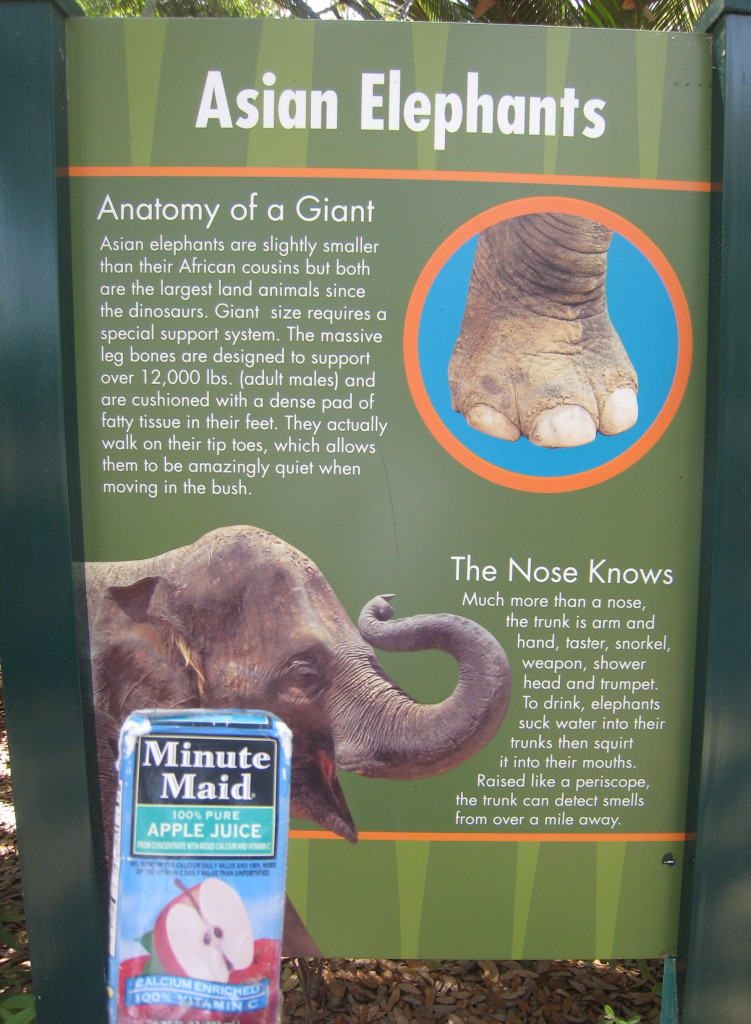
“Asian Elephants ~ Anatomy of a Giant – Asian elephants are slightly smaller than their African cousins but both are the largest land animals since the dinosaurs. Giant size requires a special support system. The massive leg bones are designed to support over 12,000 lbs. (adult males) and are cushioned with a dense pad of fatty tissue in their feet. They actually walk on their tip toes, which allows them to be amazingly quiet when moving in the bush”

“Asian Elephant, Elefante Asiatico (Elephas maximus) – Did you know? The life expectancy of elephants in the wild (and in zoos) is 45 years, but only if they are protected from poaching and habitat loss. | Animal Facts – Habitat: Forest and grassland; Diet: Herbivore; Conservation Status: Endangered”

“The McNair Asian Elephant Habitat ~ Elephant Mansion – In June 2008 our Asian elephants moved into their new home, a 7,000 square foot indoor facility complete with skylights, soft sand floors, automatic drinkers, cool ventilation, and heat in the winter. In good weather the elephants will most likely be outside an exhibit, but periodically during the day they are brought inside for training, foot care, and bath. When they are inside the barn, you can see them through the four large glass windows on the north end of the barn. This expansion will allow us to increase our elephant family in the future. | Barn Statistics – Cost: $3.5 million (of a total $5 million project); Height: 38 feet; Total Indoor Space: 7,000 square feet; Number of Stalls: The ultimate slumber party, the barn can accommodate up to 9 pachyderms in 2,625 square feet of ‘bedroom’ space; Concrete: 435 cubic yards (more than 7 times the amount used for a 3,000 square feet home); Sand: 18″ to 24″ deep in each stall; Keeper Area: Air conditioned with food prep area, computer work area and restroom and shower”
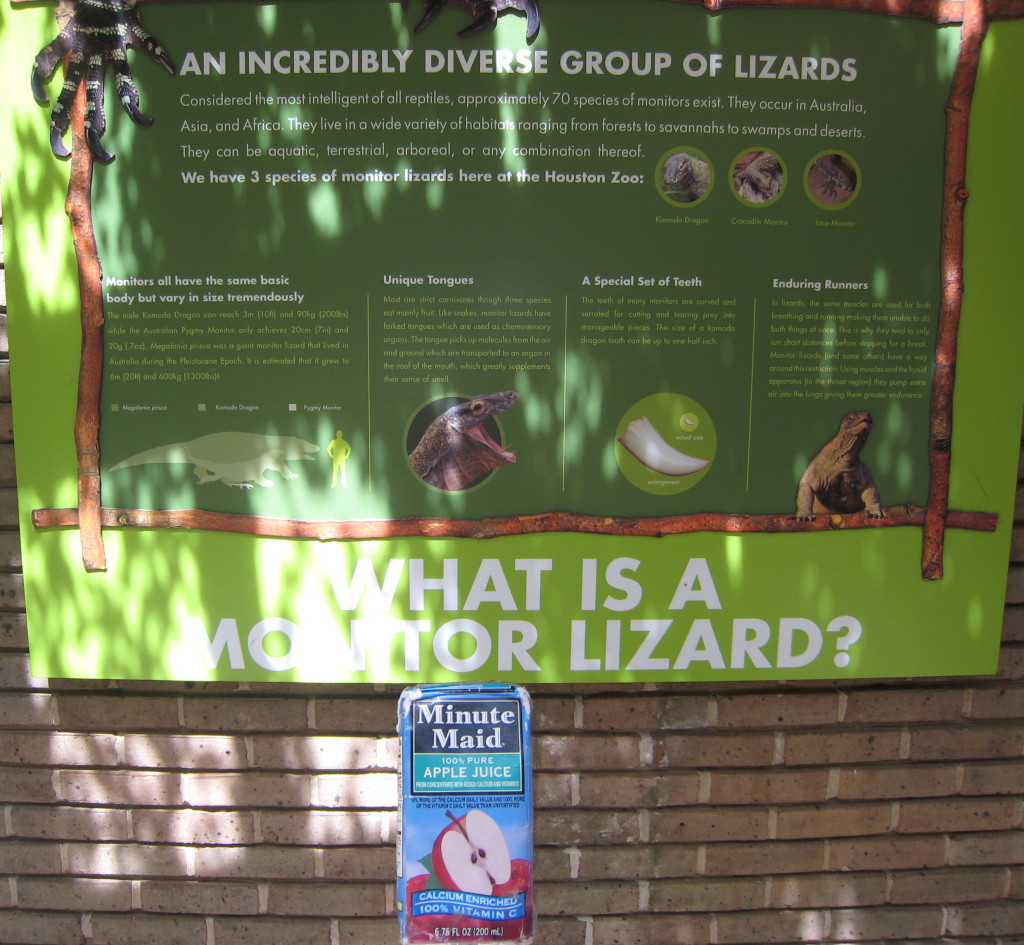
“What is a Monitor Lizard? – An Incredibly Diverse Group of Lizards ~ Considered the most intelligent of all reptiles, approximately 70 species of monitors exist. They occur in Australia, Asia, and Africa. They live in a wide variety of habitats ranging from forests to savannahs to swamps and deserts. They can be aquatic, terrestrial, arboreal, or any combination thereof. We have 3 species of monitor lizards here at the Houston Zoo: Komodo Dragon, Crocodile Monitor, Lace Monitor. | Monitors all have the same basic body but vary in size tremendously – Unique Tongues – A Special Set of Teeth – Enduring Runners”
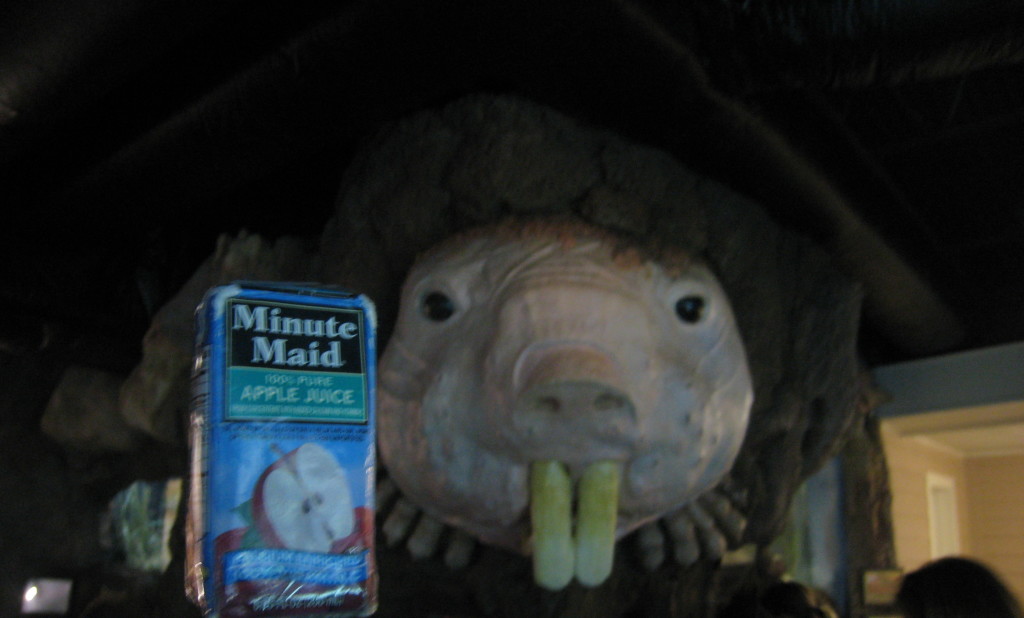
“What’s In a Name? Did you know? Mole-rats are neither moles nor rats! There are at least 27 species of mole-rat, all classified as rodents and more closely related to chinchillas and porcupines than to rats or moles.”

“Warthog ~ Home on the Range – The only pig adapted for grazing and savanna habitats, the warthog avoids forest and dense undergrowth. It grazes and roots while resting and walking on its calloused knees. The home range for warthogs averages about 500 acres. Groups of warthogs are called ‘sounders’. The family unit consists of females and young. Males are solitary as adults. Gestation is 160-170 days and the average litter size is 2-3 young. When alarmed, warthogs quickly trot as a group from danger with their tails vertically erect like antennae. | Beauty & the Beast – The ‘warts’ on the warthog are made of thickened skin and gristle, with one larger pair below the eyes and a second pair near the tusks. Warts and tusks are more pronounced in males than in females. The upper tusks of a male warthog can grow to 20 inches in length. | Early Curfew – Warthogs are highly diurnal, meaning they are active during the day. They retreat to underground burrows for safety before it gets dark.”
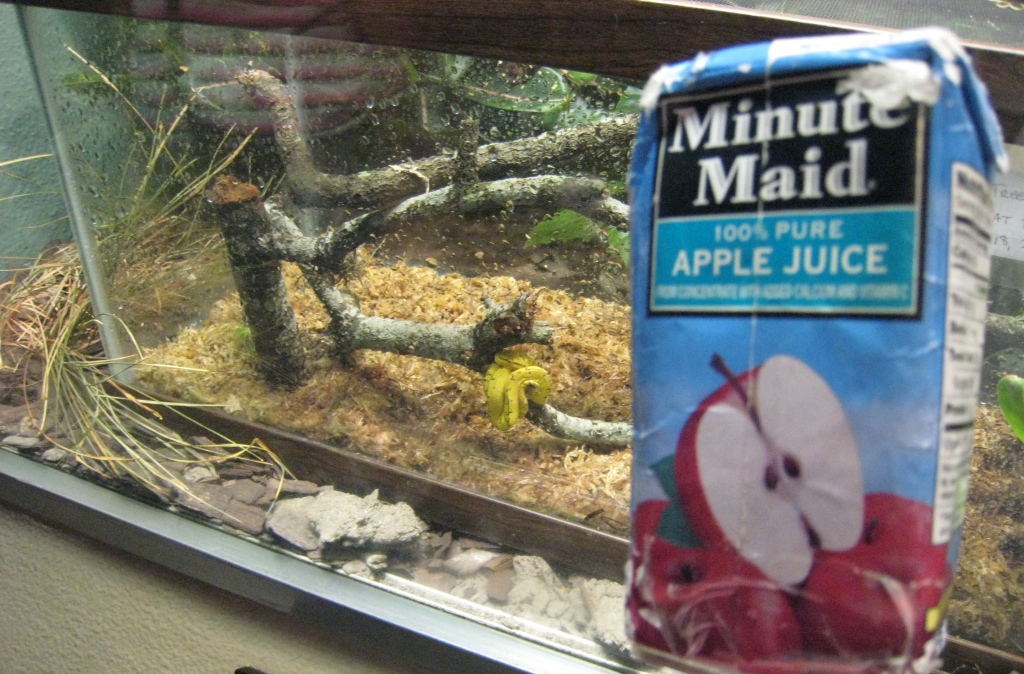
“Green tree pythons hatch at the Houston Zoo ~ Green Tree Pythons (Morelia viridis) are native to New Guinea and northern Australia. They are found in many zoo collections due to their vibrant green and yellow colors and their tropical arboreal habitat. What many visitors may not be aware of are the amazing colors that newly hatched animals exhibit – either bright yellow or brick red! These colors help them hide in their preferred habitat, which is in low lying tree branches along the forest edge. When they grow to about 22 inches long their color changes to bright green – sometimes this color change can occur in only 8 days! The red and yellow colors are not related to sex or any other trait. Red hatchlings have been found on only a few islands including New Guinea. These pythons are nocturnal so in the zoo we often have to enjoy seeing them on display sound asleep and coiled on tree branches. Green tree pythons live in any type of tropical forest including both rain forest and secondary growth forest. Adults are found high up in trees, sometimes over eighty feet above the ground. Hatchlings live near the ground and feed on lizards and invertebrates. As these pythons grow, their diet changes to one comprising small mammals and lizards. As this occurs they move higher and higher into the trees. Adults average around 4.5 feet in length. The young normally hatch sometime during November to mid December. This is just in time for the wet season, which helps to ensure a variety of food for the young pythons.”

“Komodo Dragon ~ The World’s Largest Lizard – The Komodo dragon is the world’s largest lizard, reaching a length of 10 feet and weighing in at 150 pounds. They can live up to 30 years. This endangered species is native to five islands in the South Pacific. There are between 3,000 and 5,000 Komodo dragons in the wild, with the largest population residing within Komodo National Park. Their numbers are threatened by poaching, human encroachment on their habitat and natural disasters. | What’s for Dinner? Top predators in their island habitats, Komodo dragons are meat eaters, feeding on anything they can catch or find. Komodo dragons have a keen sense of smell and excellent eyesight. They lie in wait for their prey, and then use their powerful legs, sharp claws, and serrated, shark-like teeth to bring down their prey. Adult dragons hunt on the ground, whereas juveniles hunt in the trees to avoid being eaten by larger dragons.”

“Okapi ~ Silent Forest Dwellers–The okapi lives a reclusive lifestyle in some of the most densely forested areas of the world. The okapi was not discovered by the western world until 1901, making it the largest animal to go undetected until modern times. Okapis are solitary and prefer to be by themselves in the wild. Males and females only come together to mate, after which time the female raises the calf on her own. | The Forest Giraffe – Part zebra or part horse? Actually, okapis are related to giraffes. Okapis may not have long necks like giraffes, but they do share several similarities with the world’s tallest mammal. Like giraffes, okapis have long tongues used for overhead browsing on leaves and flowers. In fact, an okapi’s tongue is long enough to clean its eyes and groom its entire body! Okapis also have fur-covered horns and a similar walking style to giraffes.”
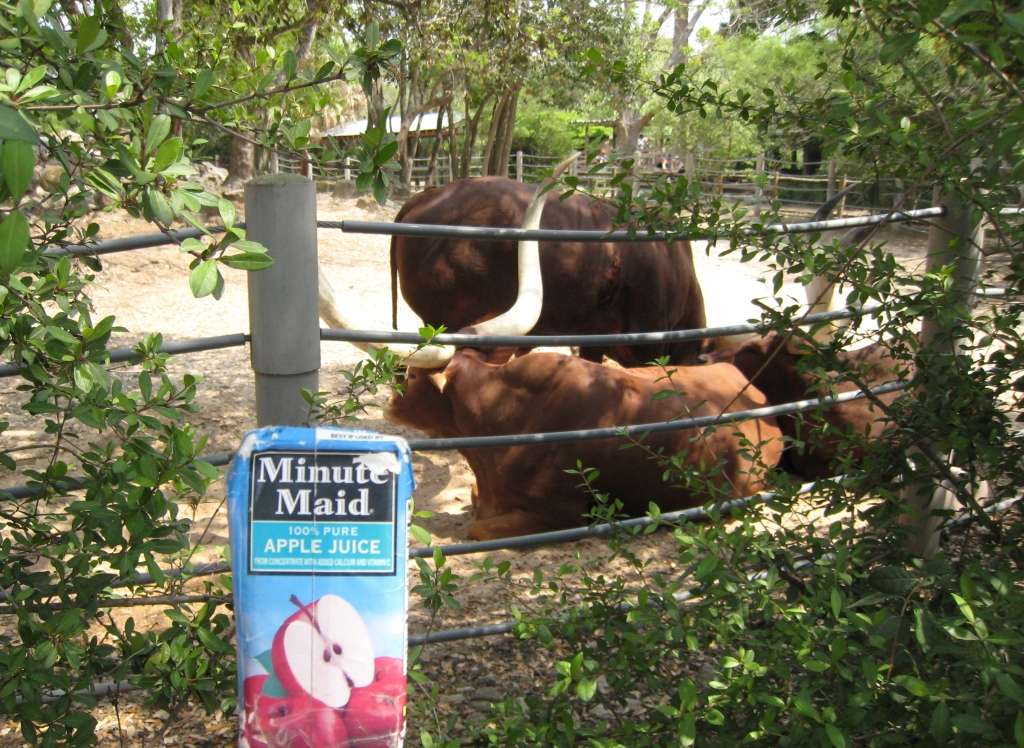
“Ankole Cattle, Ganados de Ankole (Bos taurus taurus ankole) – Did you know? The large horns of Ankole Cattle are believe to assist them in lowering their body temperature. | Animal Facts – Habitat: Grasslands and Savannas; Diet: Vegetables, Plants and Grass.”

“Crowned Lemur, Lemur Coronado (Eulemur coronatus) – Did you know? Crowned Lemurs are named for their crown-like markings on the head. They are diurnal but are know to occasionally be active at night. |Animal Facts – Habitat: Dry, deciduous forests; Diet: Fruit, young leaves, flowers, insects; Conservation Statues: Declining.”
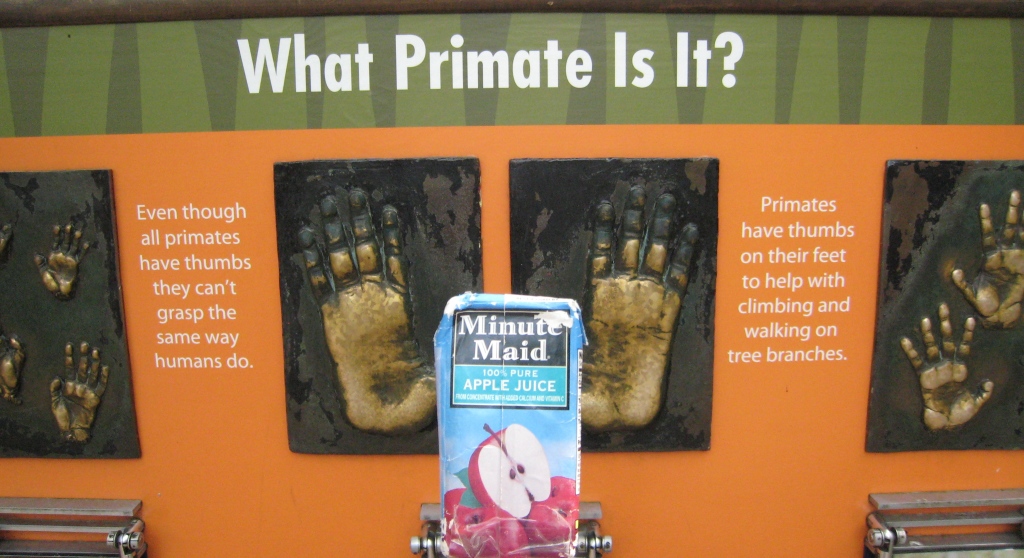
“What Primate Is It? Even though all primates have thumbs they can’t grasp the same way humans do. Primates have thumbs on their feet to help with climbing and walking on tree branches.”

“Giant Eland ~ Tall, Dark and Handsome – The eland is the world’s largest antelope. Giant eland are native to woodlands and dry savanna. Males weigh up to 1,300 pounds and stand six feet at the shoulder. Both males and females have horns, with the horns of the male being thicker, longer and more impressive. Giant eland have dark coats with distinct striping patterns on the body and a white chevron…”





